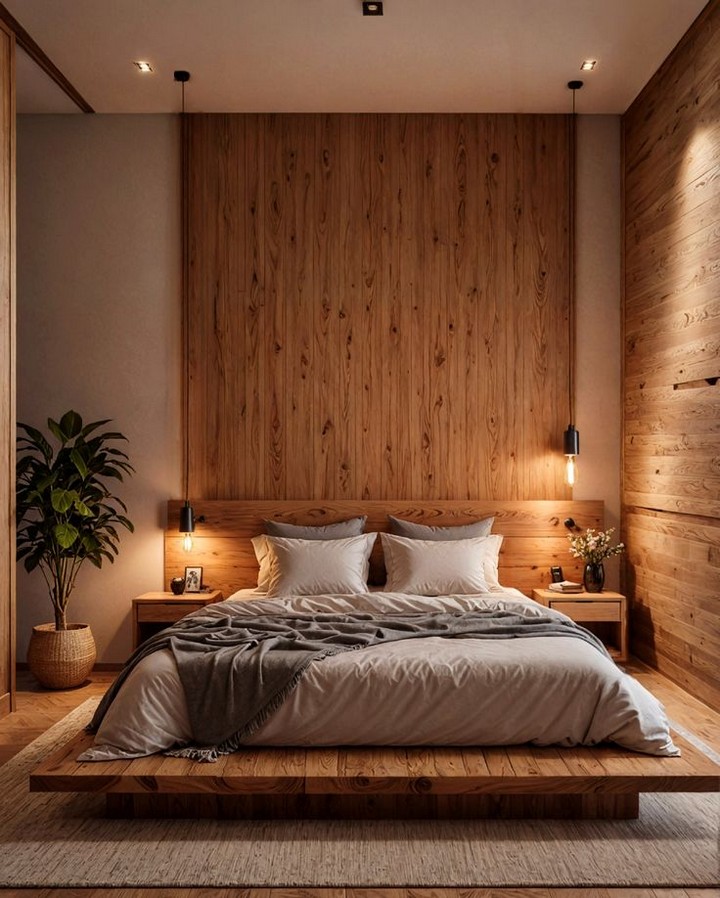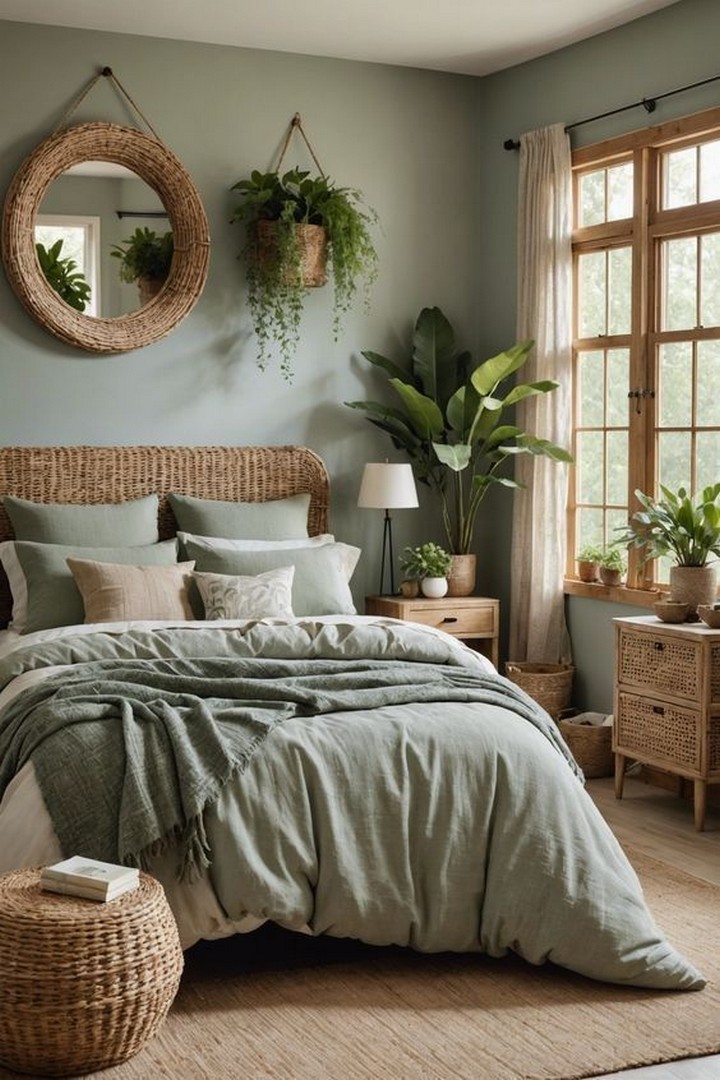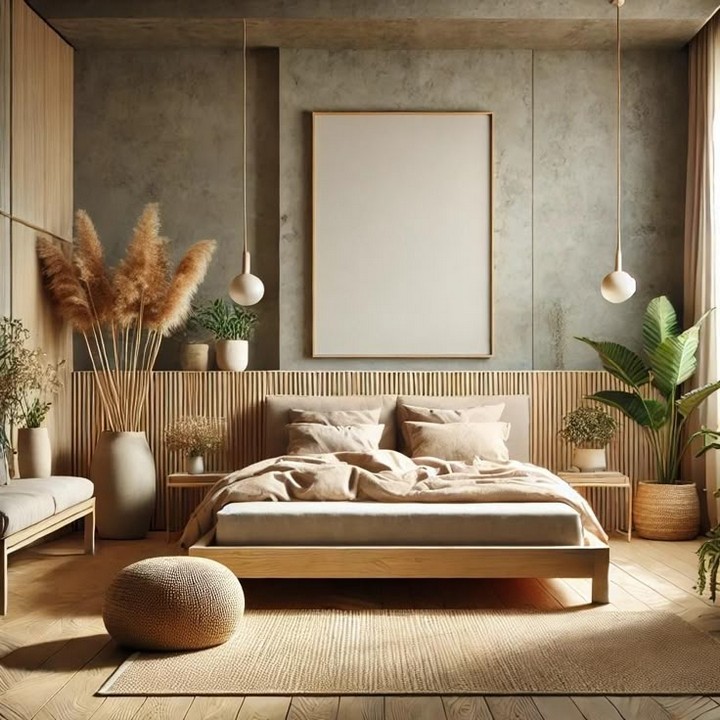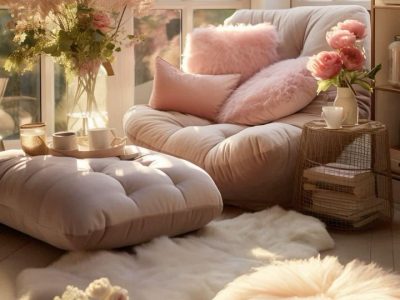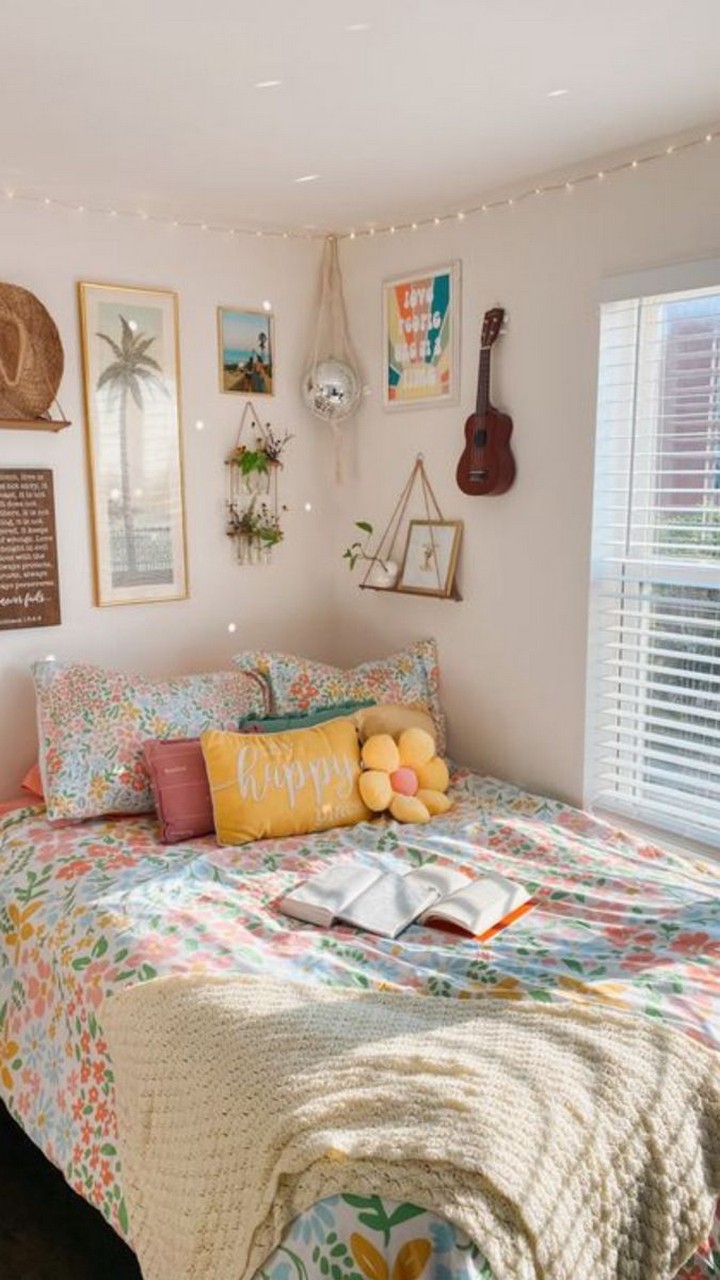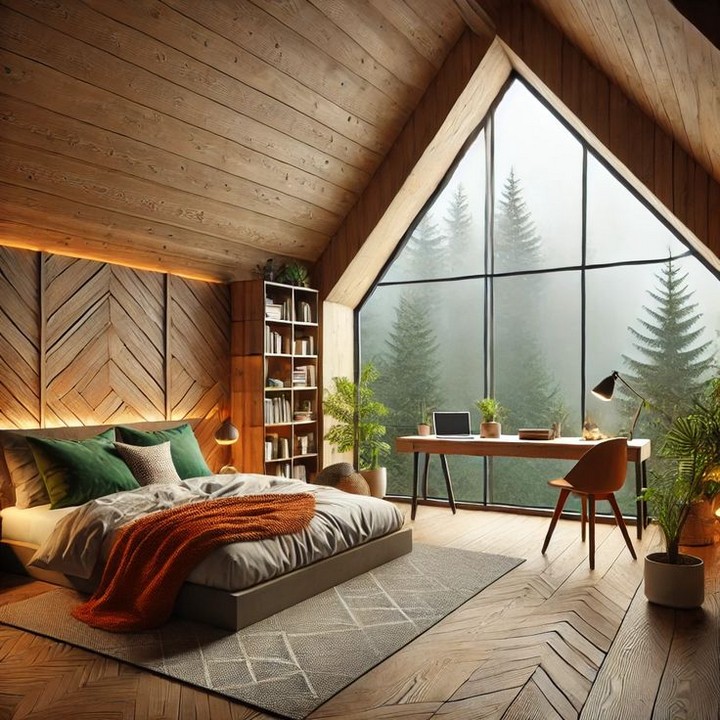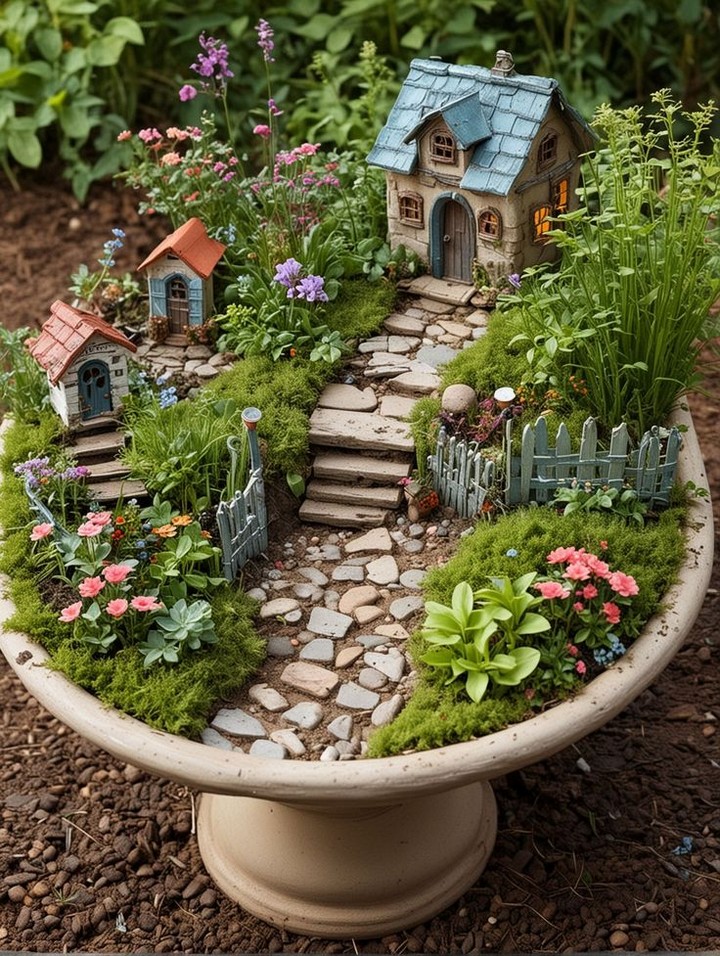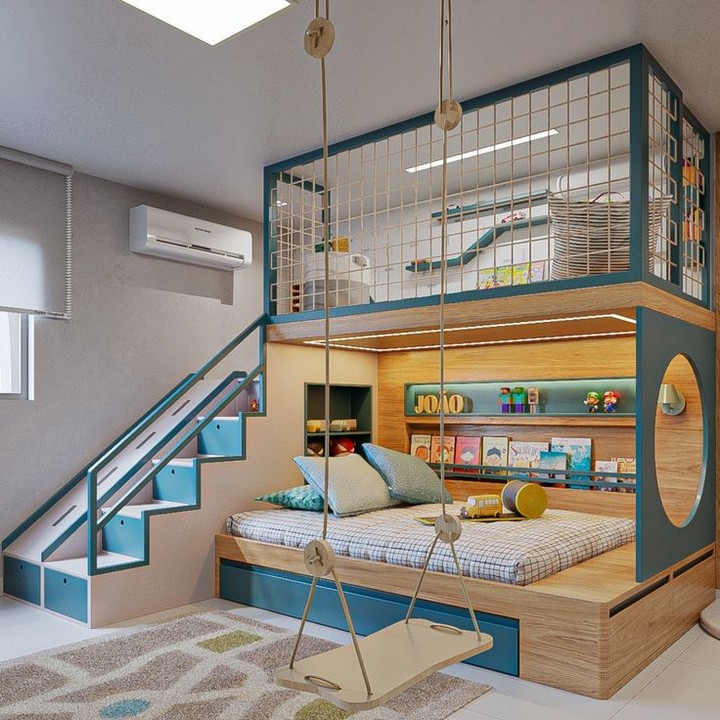Japanese interior design continues to captivate homeowners worldwide with its emphasis on minimalism, natural materials, and tranquil atmospheres. Bedrooms designed with Japanese aesthetics create peaceful retreats that promote rest and rejuvenation. In this comprehensive guide, we’ll explore 37 beautiful Japanese interior bedroom designs that blend traditional elements with modern sensibilities.
Japanese Bedroom Design
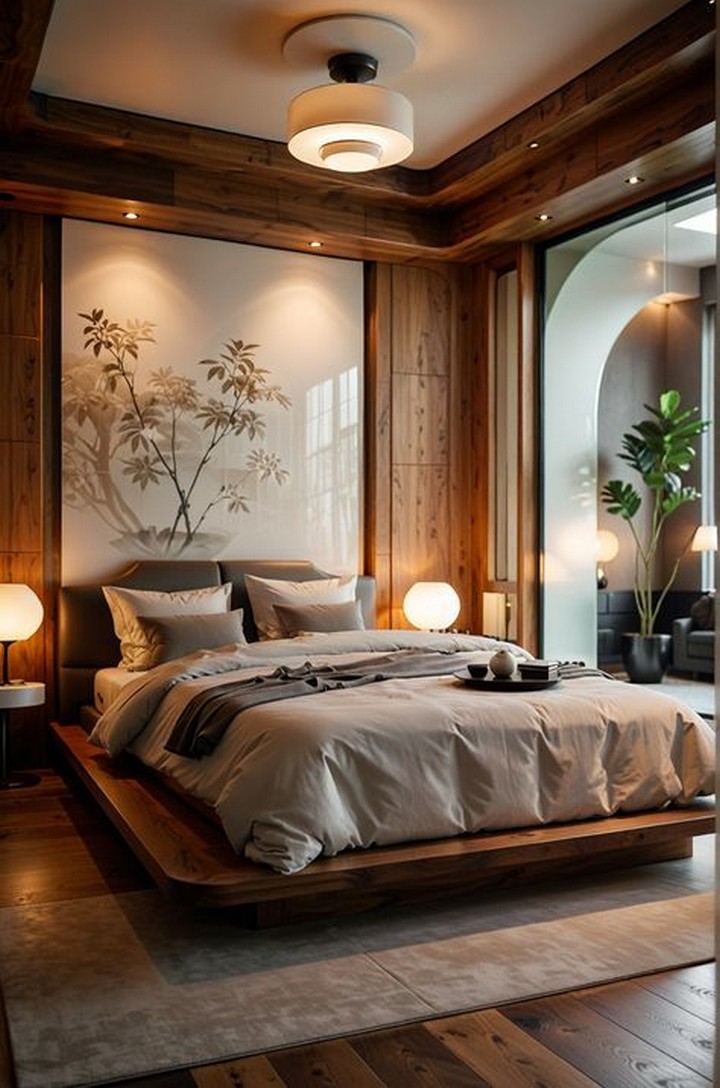
Japanese bedroom design is deeply rooted in the principles of “Ma” (negative space), “Wabi-sabi” (finding beauty in imperfection), and harmony with nature. These designs typically feature:
- Clean lines and uncluttered spaces
- Natural materials like wood, paper, and bamboo
- Neutral color palettes with occasional subtle accents
- Functional, multi-purpose furniture
- Connection to nature through plants and natural light
Each of the following bedroom designs exemplifies these principles while offering unique interpretations for different spaces and preferences.
Traditional Japanese Bedroom Designs
1. Authentic Tatami Room
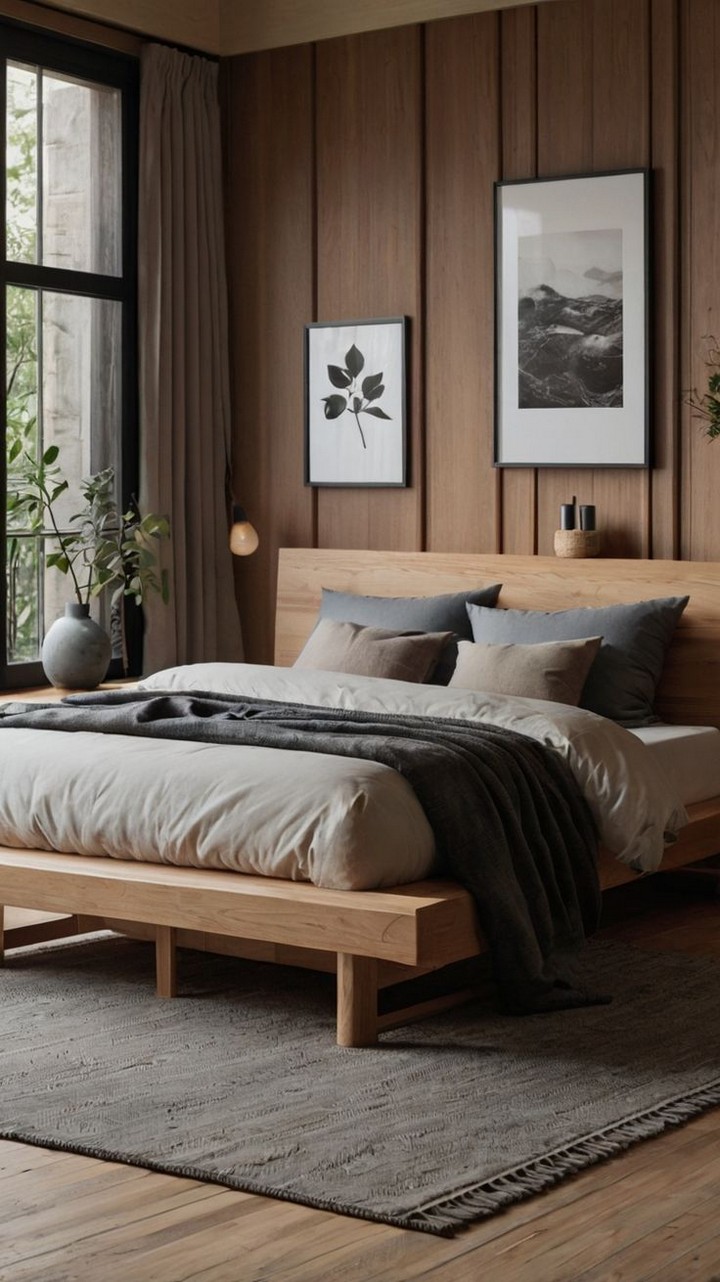
The quintessential Japanese bedroom features tatami mat flooring woven rice straw mats with distinct, refreshing scents. These rooms typically include:
- Wall-to-wall tatami flooring
- Shoji screens (translucent paper sliding doors)
- Futon bedding that’s rolled away during the day
- Low wooden furniture with clean lines
- Minimal decoration save for a single hanging scroll (kakemono)
This design prioritizes open space and flexibility, allowing the room to serve multiple purposes throughout the day.
2. Tokonoma Accent Feature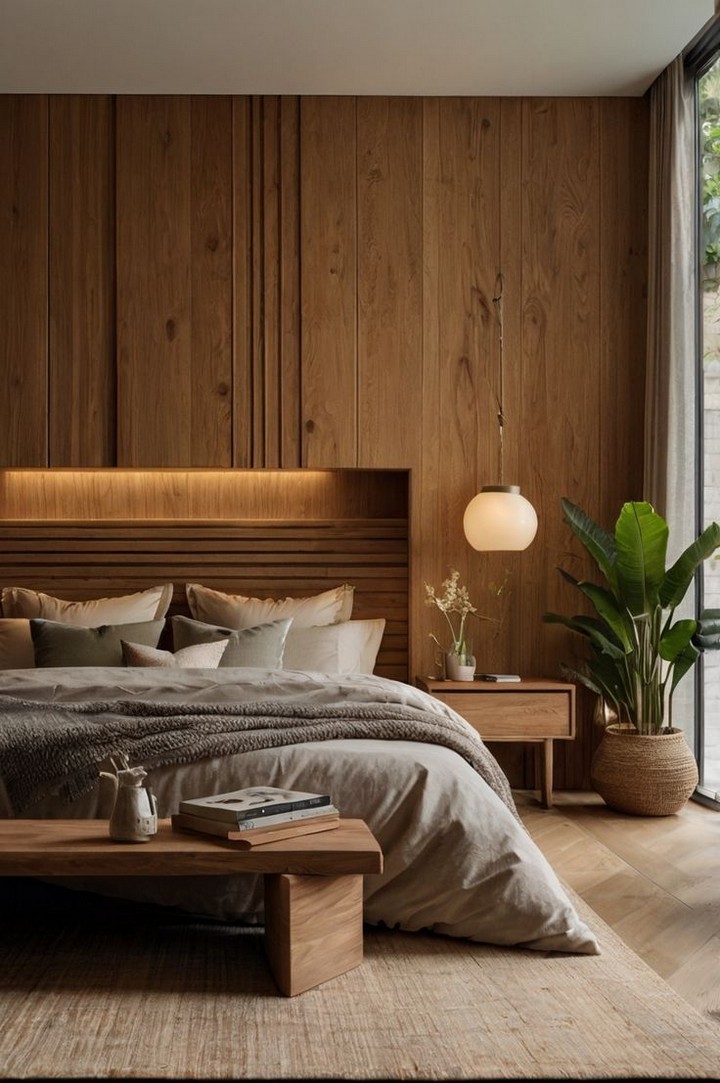
Traditional Japanese homes feature a tokonoma a recessed alcove for displaying art, ikebana (flower arrangements), or seasonal decorations. Modern Japanese bedrooms often incorporate this element as a focal point:
- Built-in recessed shelf with spotlighting
- Carefully selected seasonal art piece or calligraphy
- Small ikebana arrangement
- Natural wood framing the display area
This design element adds cultural significance and visual interest without cluttering the space.
3. Ryokan-Inspired Luxury
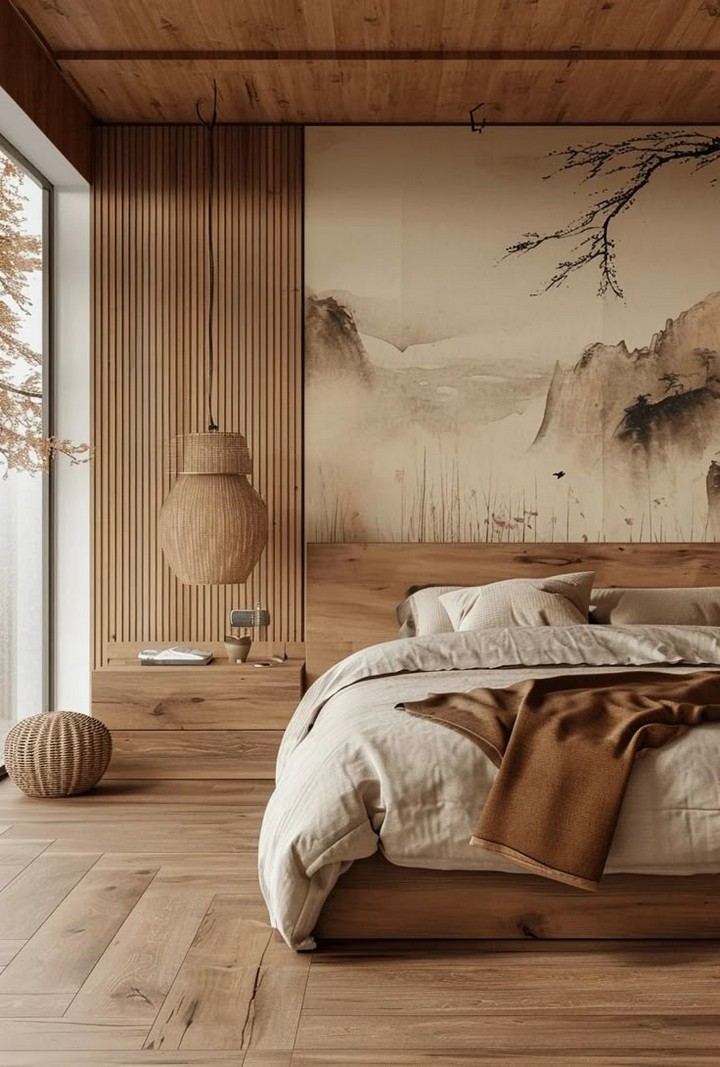
Drawing inspiration from traditional Japanese inns (ryokan), these bedrooms combine authentic elements with luxury touches:
- Premium tatami flooring
- Futon beds with high-end organic cotton bedding
- Hand-crafted wooden furniture
- Custom shoji screens with designer patterns
- High ceilings with exposed wooden beams
- Subtle recessed lighting
This approach maintains cultural authenticity while elevating comfort and sophistication.
4. Washitsu with Modern Updates
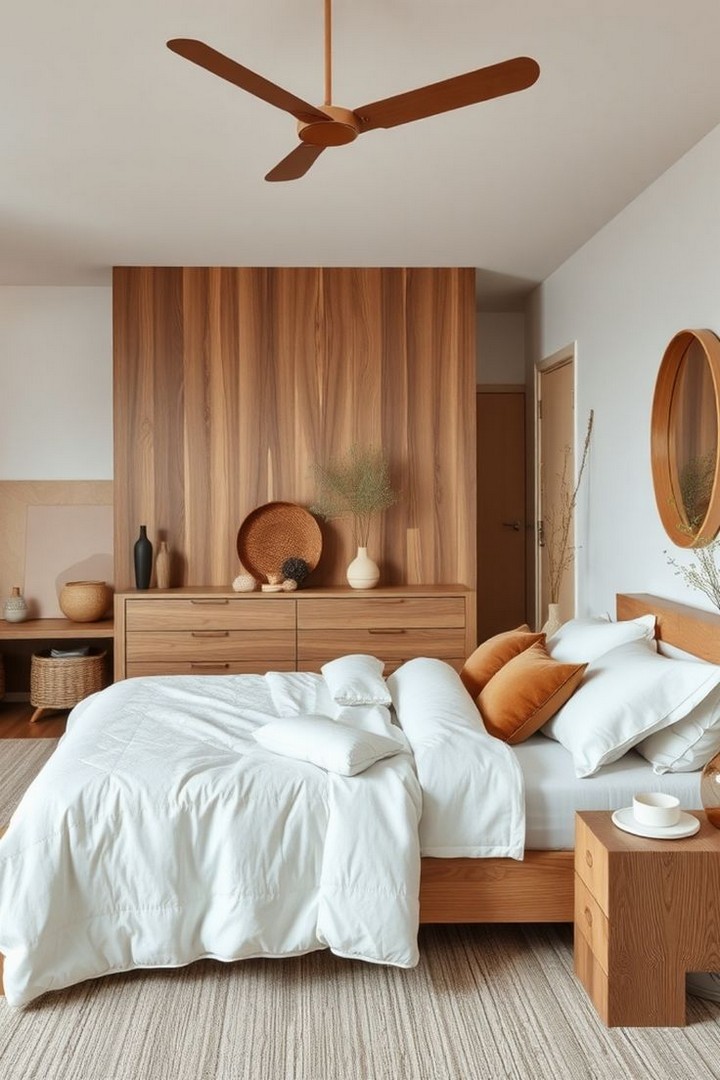
A washitsu (traditional Japanese room) can be updated for contemporary living while preserving key elements:
- Tatami floor surrounded by modern hardwood
- Sliding fusuma panels with artistic designs
- Platform bed with tatami inserts
- Built-in storage that maintains clean lines
- Modern lighting incorporated into traditional fixtures
This hybrid approach honors tradition while accommodating contemporary sleeping preferences and technology.
Modern Japanese-Inspired Bedroom Designs
5. Minimalist Zen Bedroom
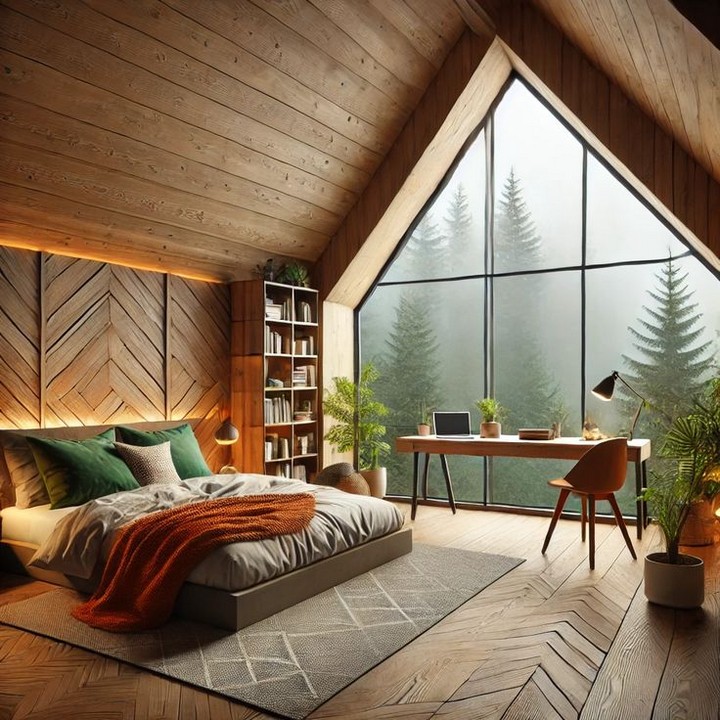
Embracing Japanese minimalism with contemporary aesthetics:
- Low platform bed with clean lines
- Monochromatic color scheme (typically whites, grays, and black)
- Single statement piece (often a calligraphy scroll or bonsai)
- Hidden storage solutions to eliminate visual clutter
- Diffused lighting through paper lanterns or recessed fixtures
This design creates ultimate tranquility through simplicity and restraint.
6. Natural Wood Haven
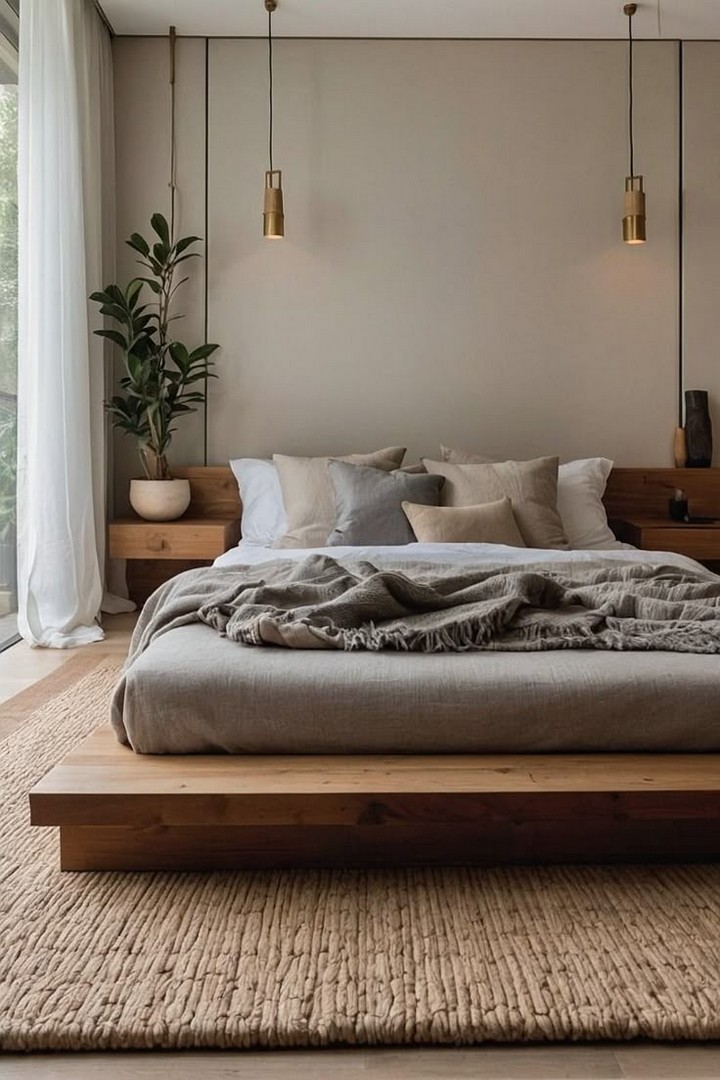
Celebrating Japan’s woodworking tradition through exposed natural elements:
- Unfinished or lightly finished wooden beams and panels
- Varying wood tones creating visual texture
- Custom platform bed with integrated nightstands
- Wood slat room dividers or headboards
- Plant life to enhance the natural atmosphere
The beauty of grain patterns and organic textures creates a warm, grounding space.
7. Japandi Fusion
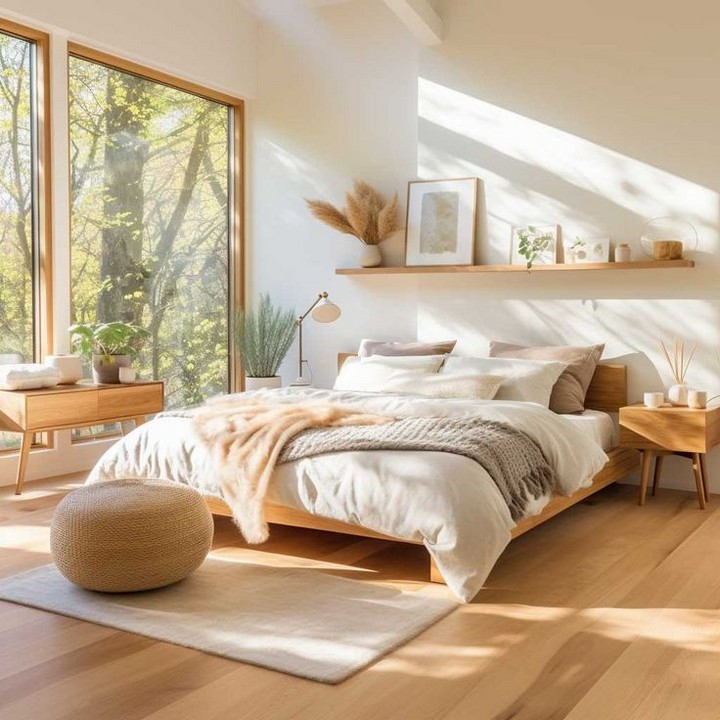
Blending Japanese minimalism with Scandinavian functionality:
- Light wood tones with white walls
- Low-profile furniture with both Japanese and Nordic influences
- Textural contrast through linen, cotton, and wool
- Thoughtfully placed ceramics and natural objects
- Warm, cozy lighting combined with clean lines
This increasingly popular style marries the best of both design traditions.
8. Urban Micro Japanese Bedroom
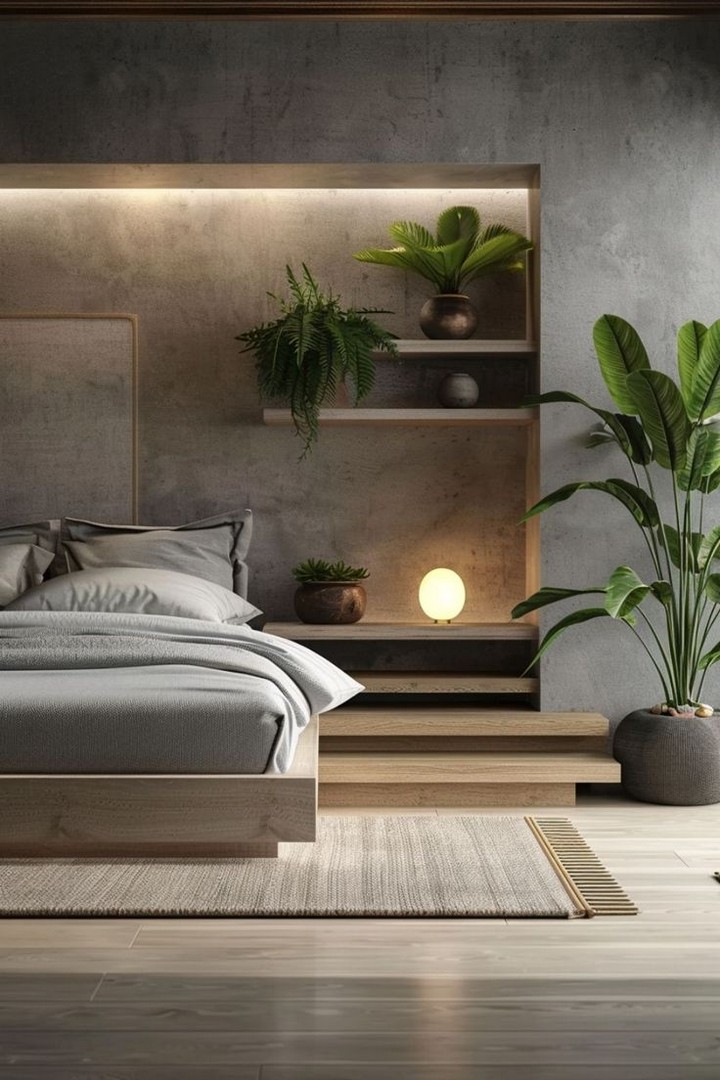
Adapting Japanese principles for small urban apartments:
- Multi-functional platform bed with storage drawers
- Wall-mounted or sliding furniture to maximize floor space
- Shoji-inspired room dividers that let light through
- Vertical storage solutions with clean lines
- Digital artwork displaying nature scenes
This approach brings Japanese efficiency and serenity to compact living spaces.
Elements of Japanese Design in Bedrooms
9. Shoji-Inspired Window Treatments
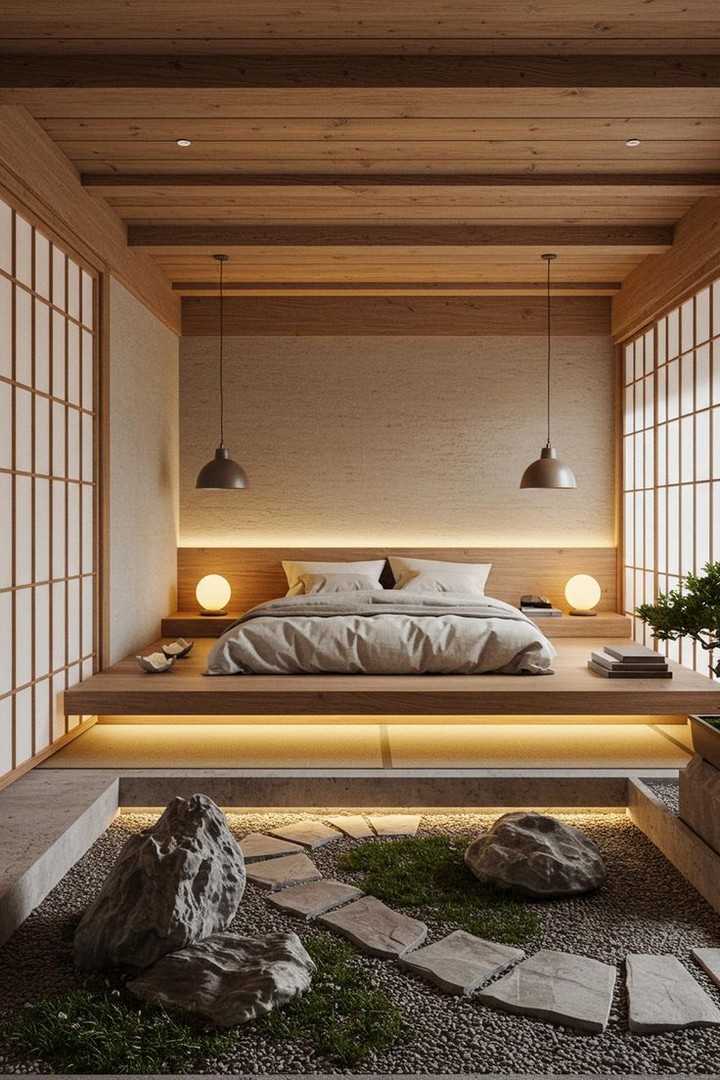
Adapting traditional paper screens for modern windows:
- Custom wooden frames with translucent panels
- Sliding screen systems for large windows or doors
- Light-filtering capabilities that maintain privacy
- Natural wood tones complementing other bedroom elements
- Clean geometric patterns creating visual interest
These solutions offer the aesthetic of shoji with improved durability and function.
10. Futon and Floor Seating Areas
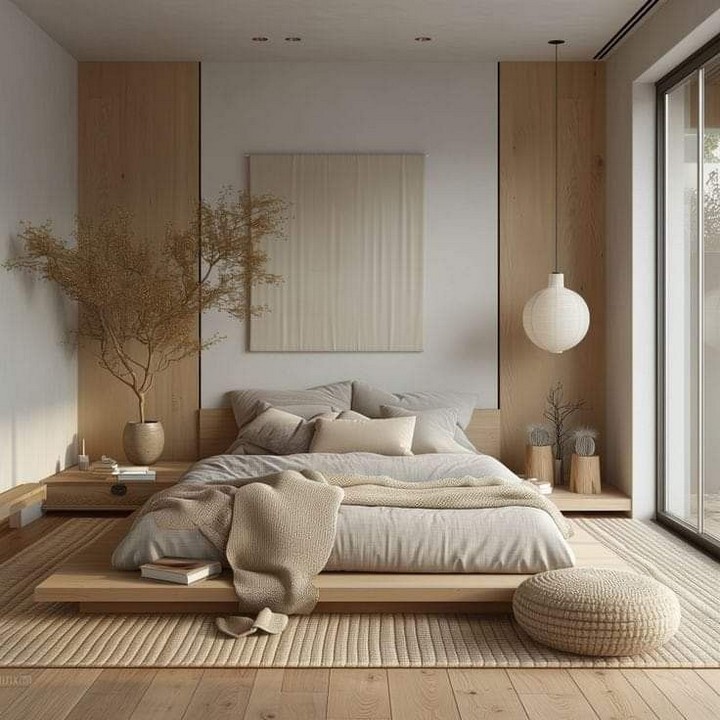
Creating flexible sleeping and relaxation zones:
- Traditional Japanese futon with storage cabinet (futon-dansu)
- Zabuton floor cushions for reading or meditation
- Low chabudai table for tea or breakfast in bed
- Tatami or bamboo mat defining the seating area
- Folding screens for privacy when needed
This arrangement allows for multi-purpose use of bedroom space.
11. Natural Material Palette
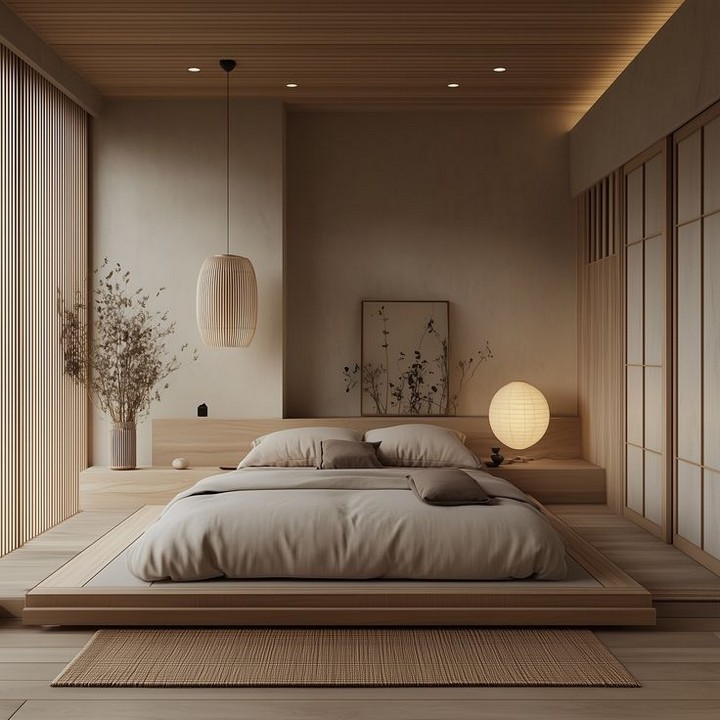
Incorporating authentic Japanese material choices:
- Cypress, cedar, or pine structural elements
- Bamboo accents and accessories
- Natural linen or cotton bedding in neutral tones
- Paper lanterns providing soft, diffused light
- Stone or clay decorative elements
These materials create sensory richness while maintaining visual simplicity.
12. Sliding Door Systems
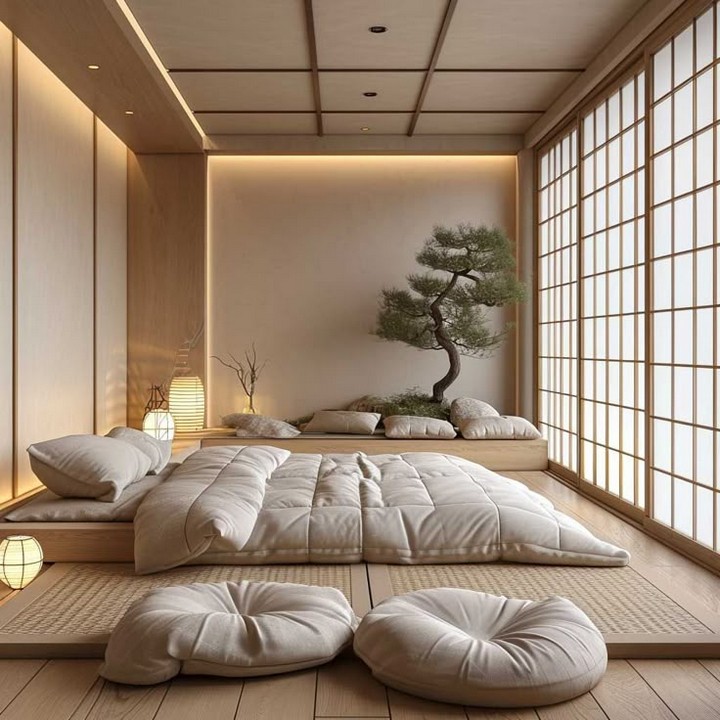
Implementing space-saving Japanese door solutions:
- Wooden track systems for smooth, quiet operation
- Custom door designs ranging from traditional to contemporary
- Space-efficient closet and bathroom access
- Room dividers that can open to create larger spaces
- Integrated handles that maintain clean lines
These doors maximize usable space while adding architectural interest.
Japanese Color Schemes for Bedrooms
13. Traditional Indigo and White
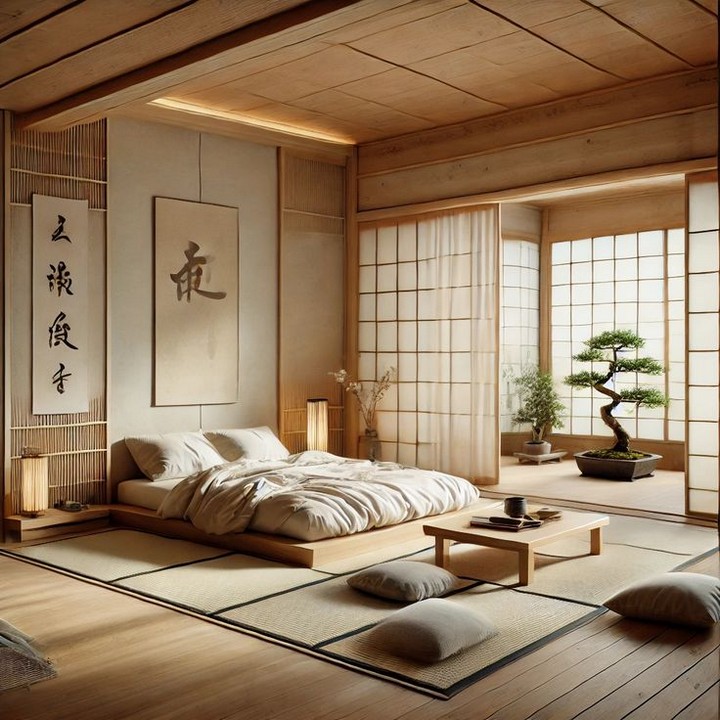
Drawing from Japan’s textile tradition:
- Shibori-dyed textile accents (Japanese tie-dye technique)
- Deep indigo walls or feature panels
- Crisp white bedding creating striking contrast
- Natural wood elements to warm the palette
- Ceramic accessories with blue and white patterns
This timeless color scheme feels both authentic and fresh.
14. Shades of Clay and Earth
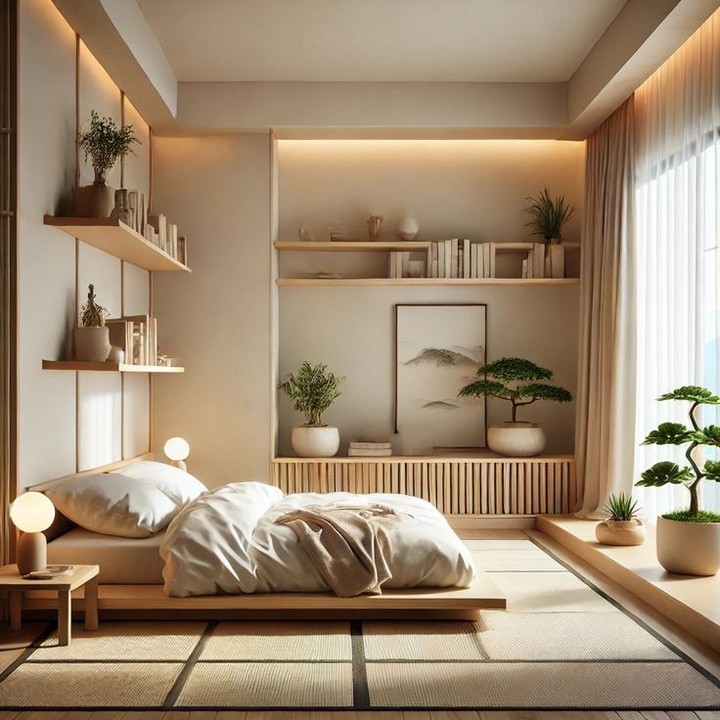
Inspired by Japanese pottery and natural landscapes:
- Terracotta, umber, and sienna tones
- Natural clay wall finishes with subtle texture
- Unglazed ceramic accessories and lighting
- Walnut or darker wood furniture
- Raw silk or linen textiles in complementary earth tones
These warm neutrals create a grounding, serene atmosphere.
15. Zen Monochrome
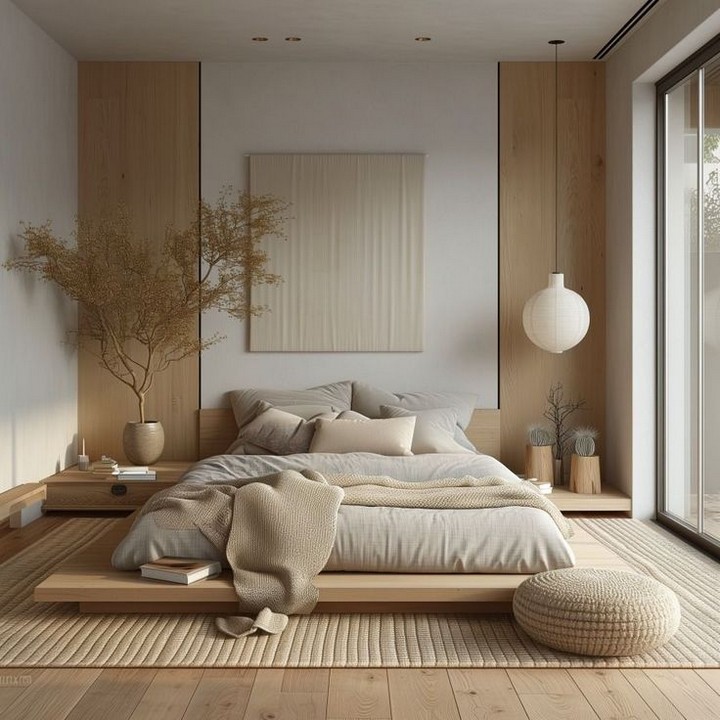
Creating serenity through restrained color:
- Varying shades of a single color (often gray or taupe)
- Textural variety providing visual interest despite limited color
- Black accents for grounding and definition
- White space maintaining lightness and air
- Single subtle accent color in a carefully chosen accessory
This approach creates extreme visual calm through color restraint.
16. Cherry Blossom Inspiration
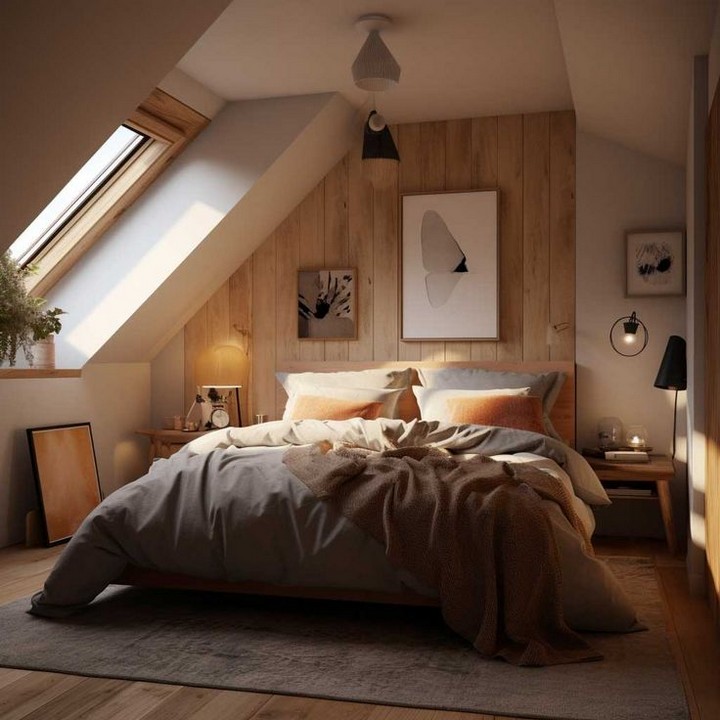
Incorporating Japan’s beloved sakura in subtle ways:
- Pale pink accents against neutral backgrounds
- Botanical prints of cherry blossoms in simple frames
- Textiles with subtle blossom patterns
- Actual cherry branches during blossom season
- Lighting that creates a soft pink glow
This feminine approach maintains Japanese restraint while adding gentle color.
Japanese-Inspired Bed Designs
17. Traditional Futon Arrangement
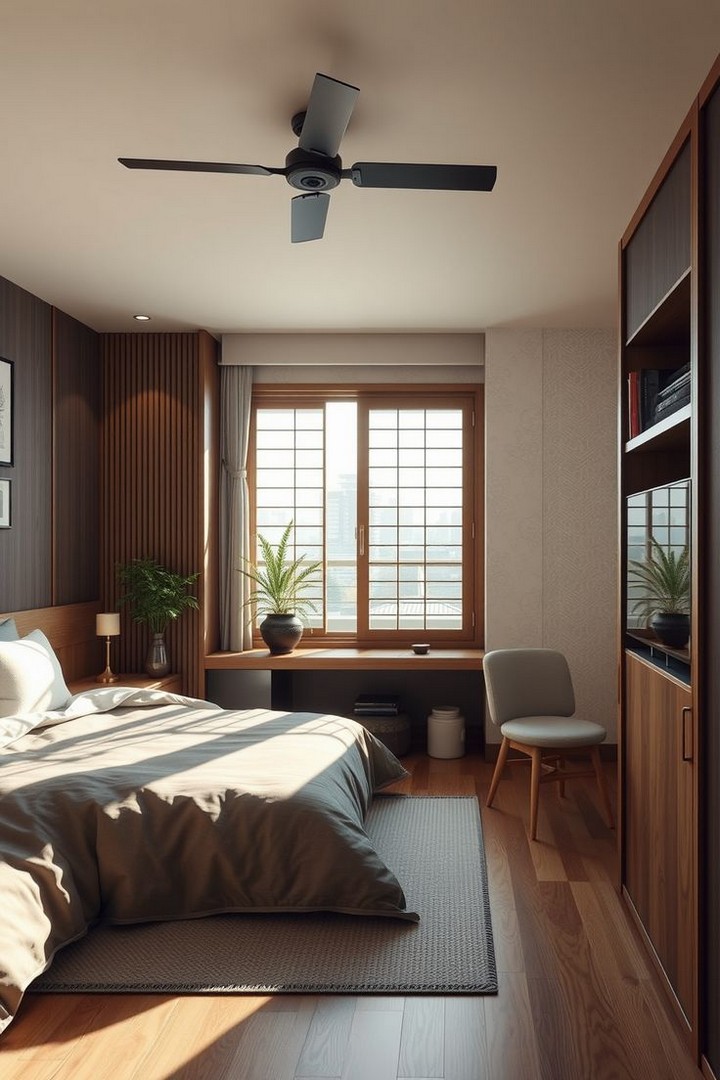
The authentic Japanese sleeping experience:
- High-quality cotton futon mattress (shikibuton)
- Folding mattress stored in custom cabinet during day
- Traditional buckwheat hull pillow (sobakawa)
- Simple cotton bedding in white or natural tones
- Tatami mat foundation providing natural support
This approach offers authentic culture and space efficiency.
18. Low Platform Bed
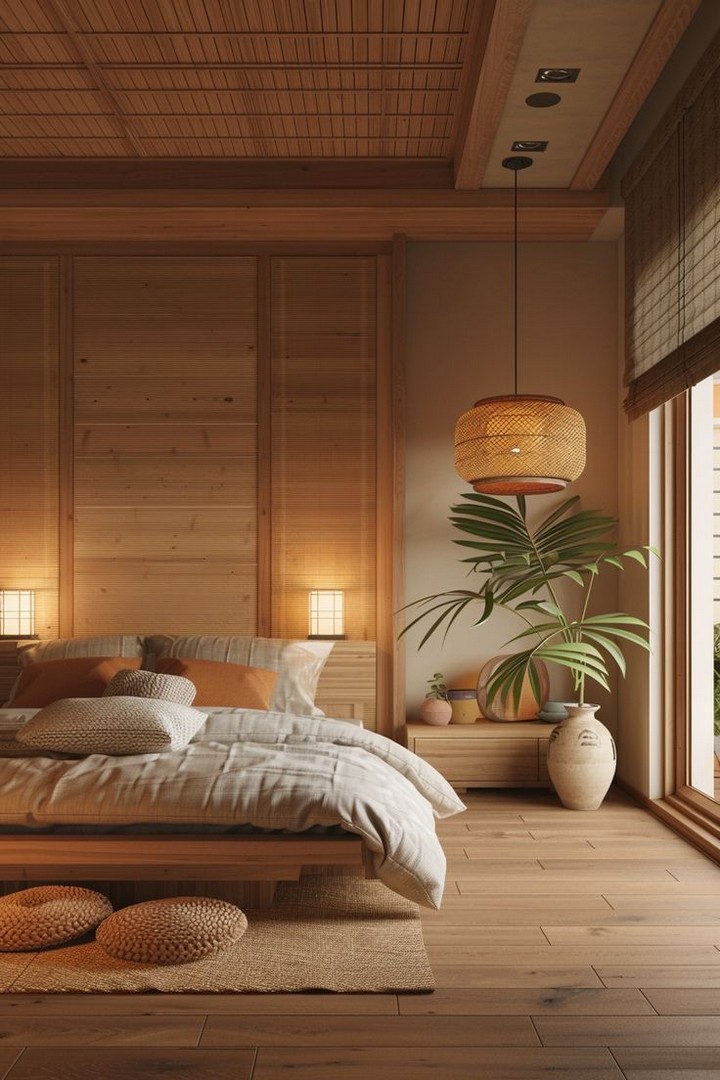
The most common adaptation of Japanese sleeping style:
- Solid wood platform just inches from the floor
- No box spring, allowing for lower profile
- Clean headboard design or no headboard at all
- Hidden supports creating a “floating” appearance
- Minimal bedding without excessive pillows or layers
This design maintains the low-to-ground aesthetic while offering Western comfort.
19. Tatami Platform Bed
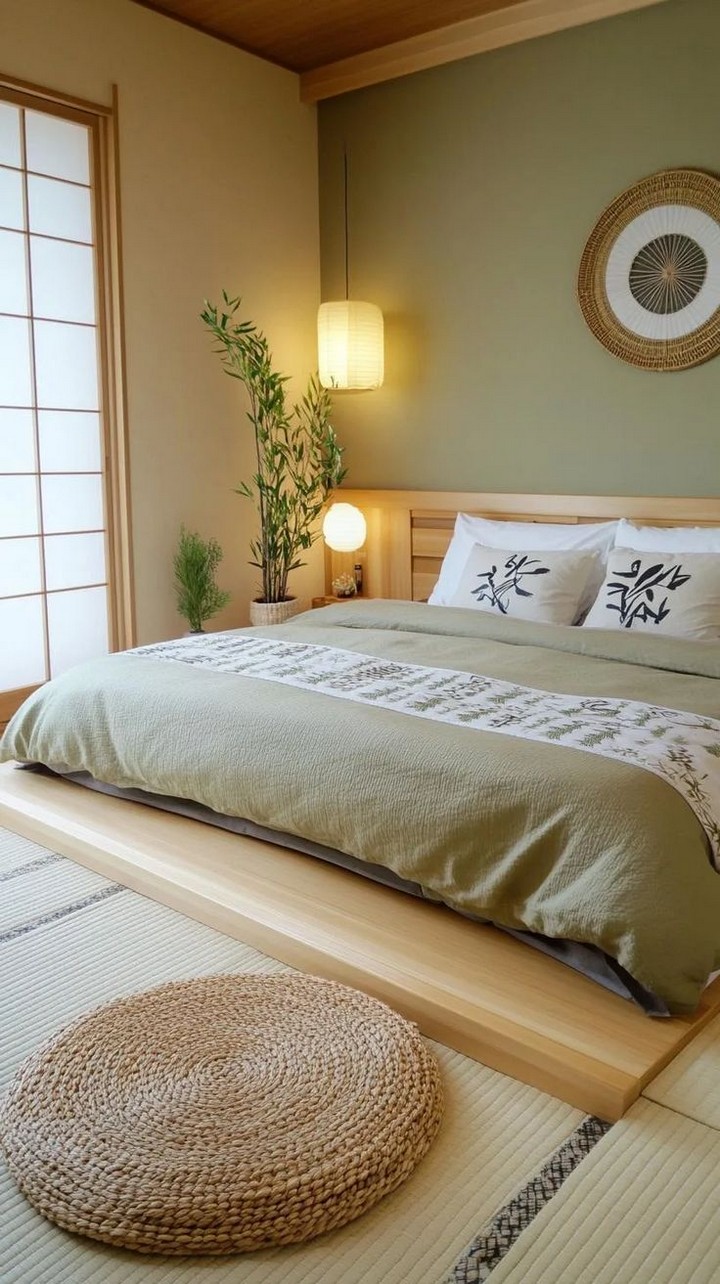
Combining traditional materials with contemporary form:
- Wooden platform with inset tatami panels
- Traditional rice straw mats providing natural cooling
- Modern mattress placed directly on tatami
- Organic cotton or linen bedding
- Integrated nightstands continuing the platform design
This hybrid honors traditional materials while accommodating modern preferences.
20. Floor Bed With Custom Headboard
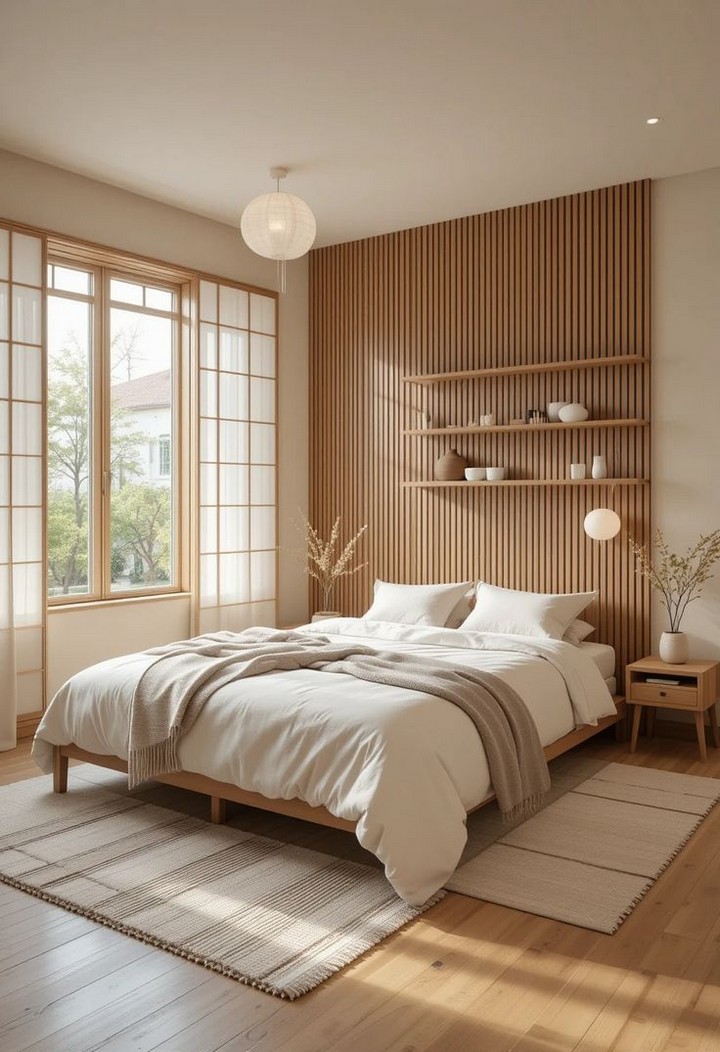
Creating architectural interest with Japanese simplicity:
- Mattress placed directly on tatami or platform
- Dramatic wooden headboard with Japanese joinery
- Built-in lighting integrated into headboard design
- Low side tables proportioned to bed height
- Minimal, high-quality bedding in neutral tones
This approach creates visual impact while maintaining the low-profile aesthetic.
Japanese Bedroom Storage Solutions
21. Modern Tansu Cabinets
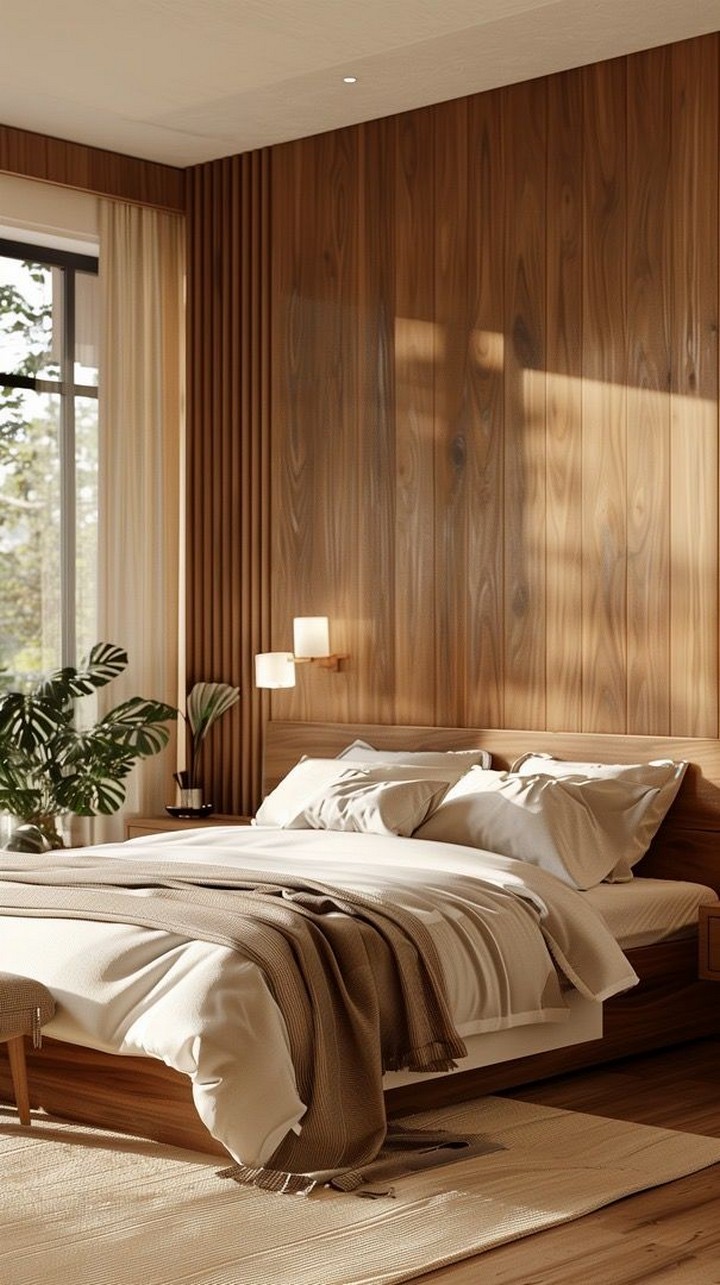
Updates on traditional Japanese storage chests:
- Step-tansu designs with asymmetrical compartments
- Hidden compartments and secret drawers
- Custom hardware with Japanese motifs
- Natural wood finishes showcasing grain patterns
- Multi-functional pieces that serve as room dividers
These pieces offer beautiful craftsmanship and practical storage.
22. Built-In Closet Systems
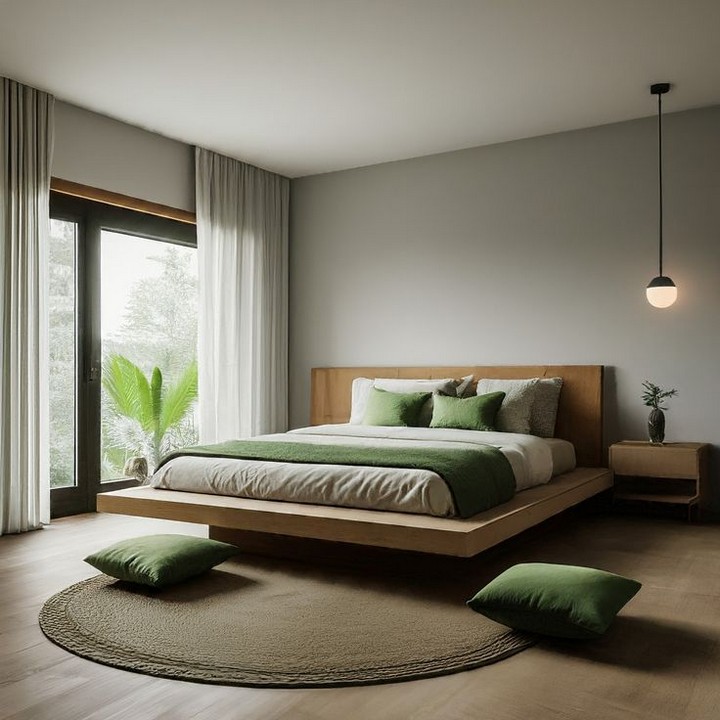
Adapting Japanese efficiency to modern wardrobes:
- Sliding door systems that save space
- Interior organization based on traditional kimono storage
- Visible joinery details celebrating craftsmanship
- Natural wood finishes without excessive hardware
- Compartmentalized storage for smaller items
These systems blend seamlessly with bedroom architecture while providing ample storage.
23. Under-Platform Storage
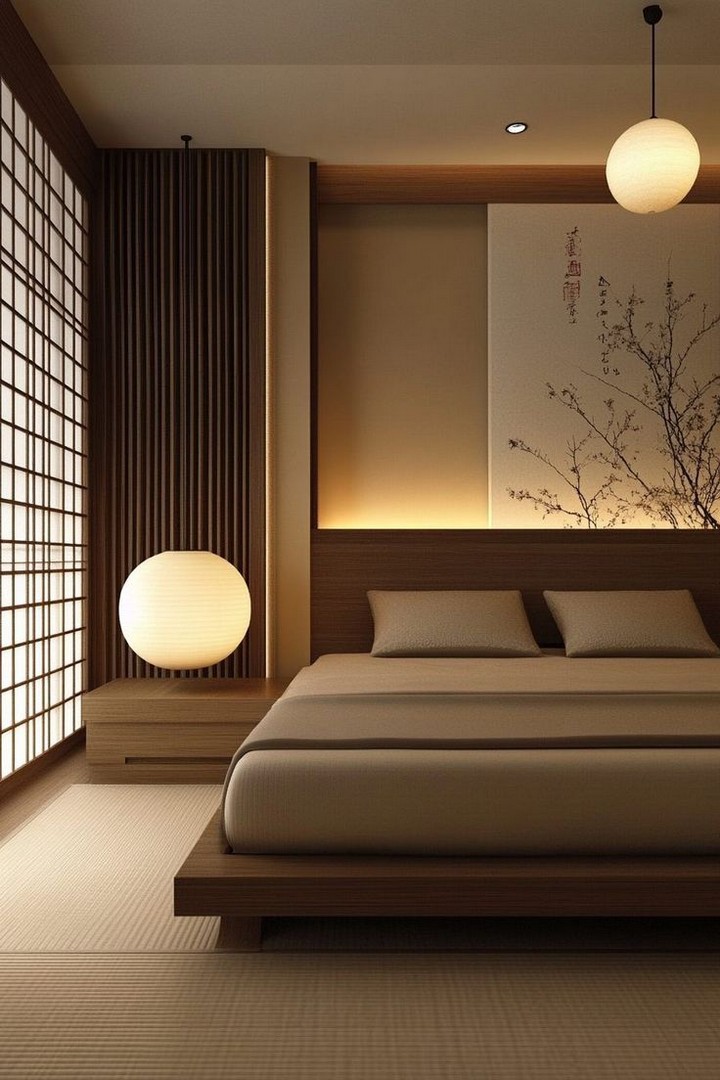
Maximizing efficiency with multi-purpose bed designs:
- Hydraulic lift systems exposing storage beneath platforms
- Custom drawers built into bed bases
- Modular compartments for seasonal storage
- Clean, handle-free drawer fronts maintaining visual simplicity
- Space for storing futons or guest bedding
This approach maximizes space efficiency while maintaining clean aesthetics.
24. Minimal Open Shelving
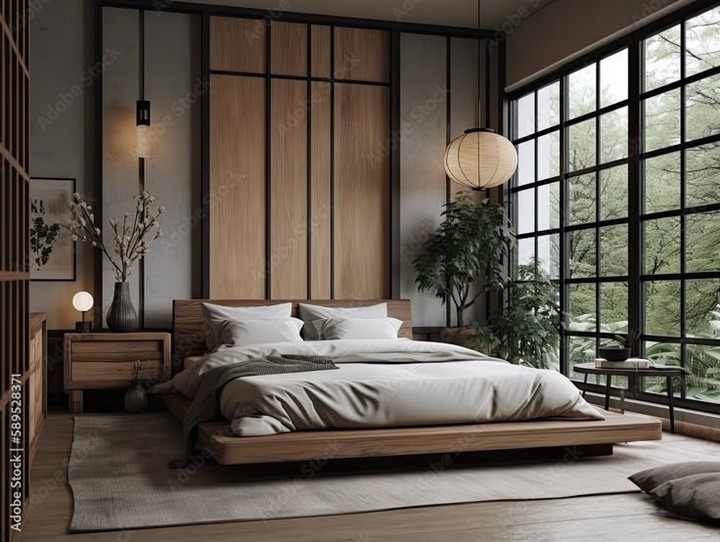
Creating intentional display areas with Japanese restraint:
- Simple floating wooden shelves
- Curated display following “less is more” philosophy
- Equal negative space between objects
- Natural objects and handcrafted items carefully arranged
- Seasonal rotation of displayed items
This storage solution doubles as an artistic expression of Japanese aesthetics.
Natural Elements in Japanese Bedrooms
25. Indoor Zen Garden Features
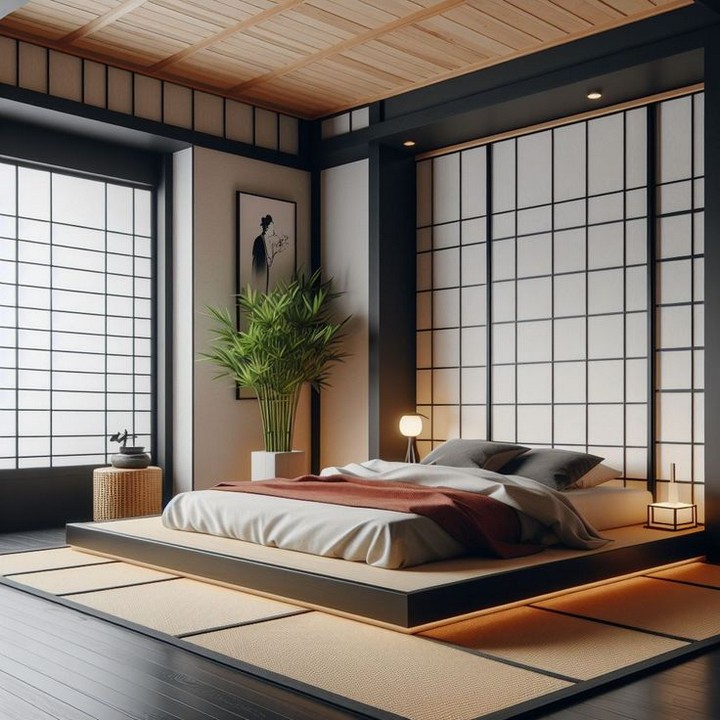
Bringing meditative garden elements indoors:
- Miniature sand gardens with raking patterns
- Carefully placed stones creating visual balance
- Shallow wooden trays defining the garden space
- Single carefully chosen plants (often moss or small ferns)
- Minimal maintenance requirements for urban environments
These features add contemplative focus to bedroom spaces.
26. Bonsai and Kokedama Displays
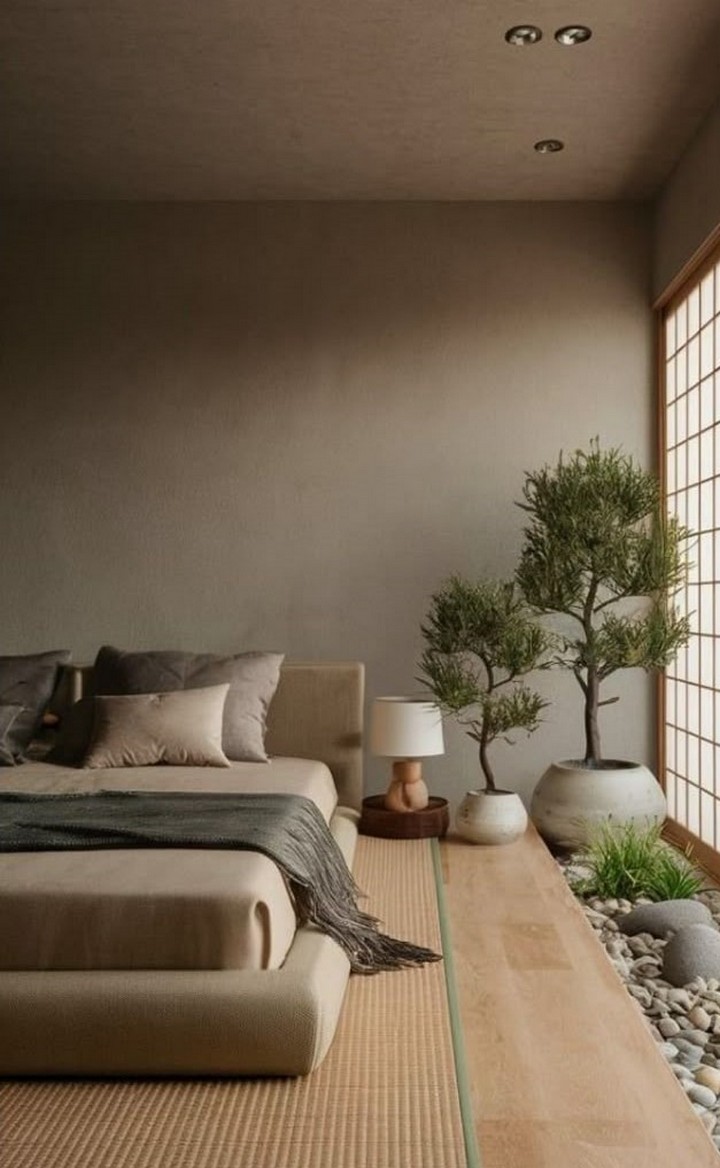
Including traditional Japanese plant art:
- Aged bonsai trees in simple ceramic containers
- Moss ball (kokedama) hanging installations
- Specialized display shelves with proper lighting
- Seasonal rotation based on traditional Japanese calendar
- Simplified care routines for bedroom environments
These living sculptures add natural beauty without overwhelming the space.
27. Bamboo Accents
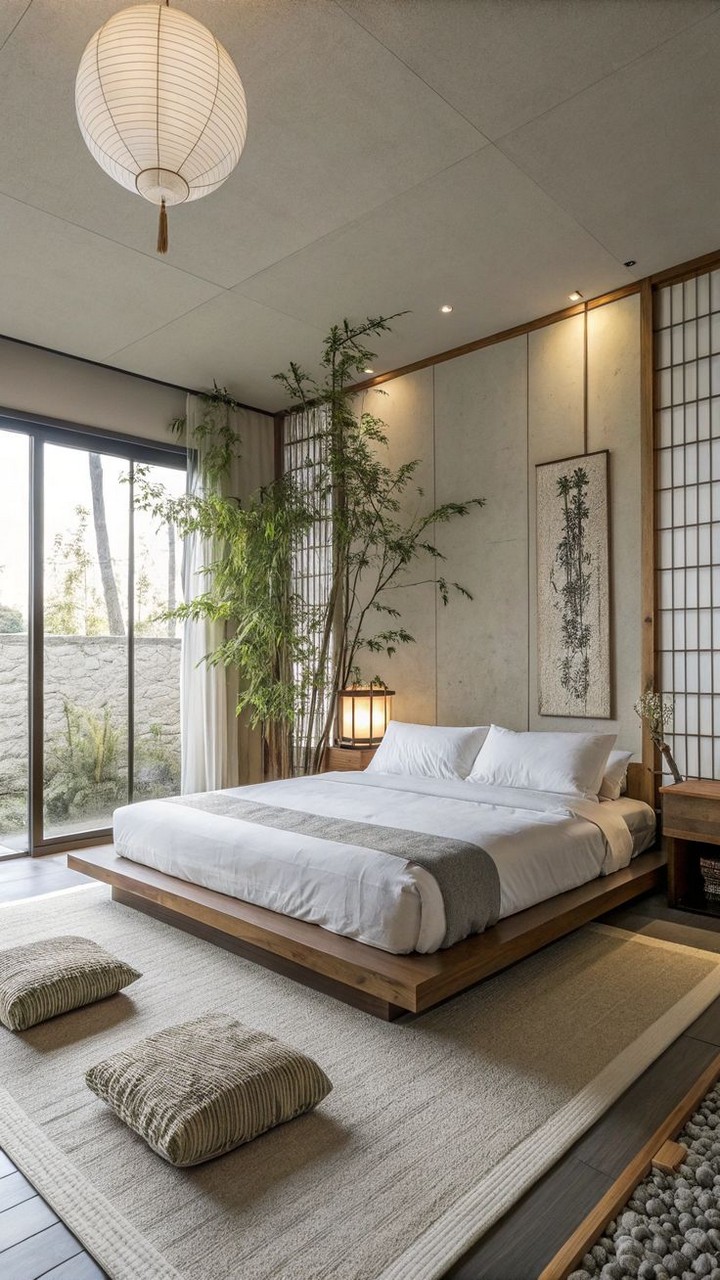
Incorporating this quintessential Japanese material:
- Bamboo room dividers or screens
- Live bamboo plants in simple containers
- Bamboo mat floor coverings as alternatives to tatami
- Bamboo charcoal for natural air purification
- Bamboo textiles for bedding and window coverings
This sustainable material adds texture and connects to Japanese tradition.
28. Water Features
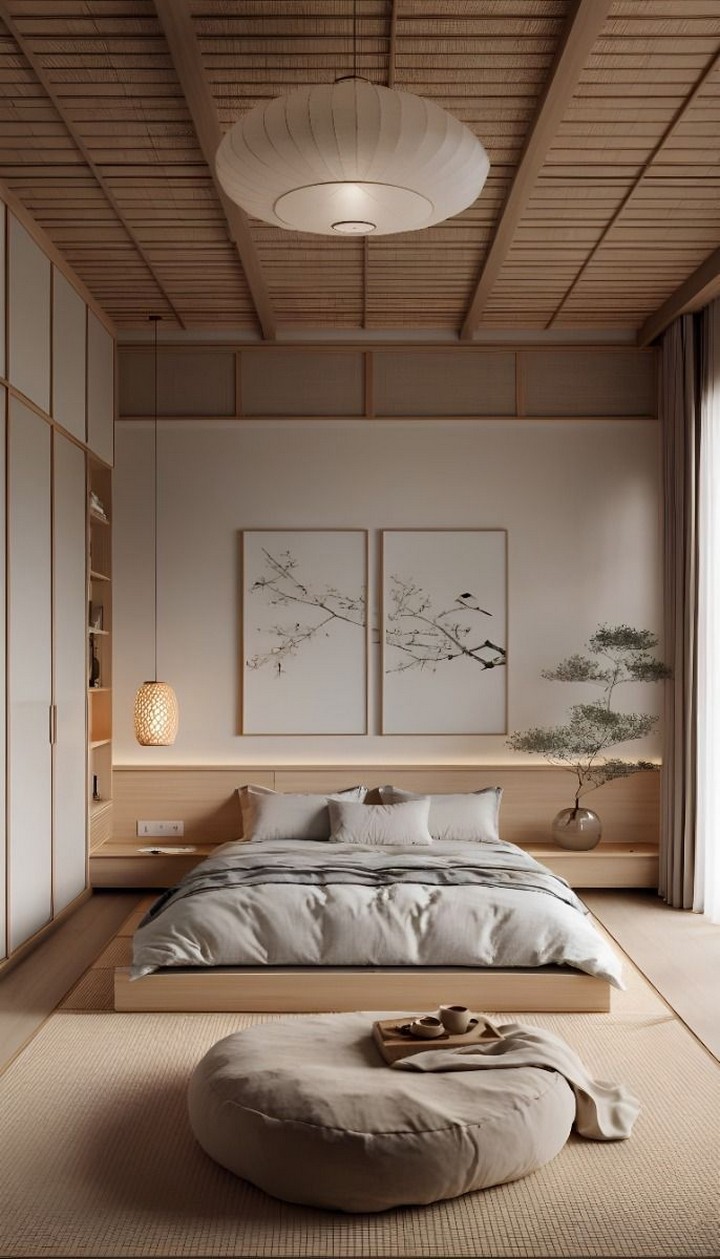
Adding the gentle sounds of water:
- Miniature tabletop fountains with Japanese design
- Bamboo shishi-odoshi (deer scarer) adapted for indoor use
- Small aquatic plant displays in ceramic vessels
- Humidity-enhancing features for dry environments
- Sound machines mimicking Japanese garden water sounds
These elements engage multiple senses while promoting relaxation.
Lighting in Japanese Bedrooms
29. Paper Lantern Installations
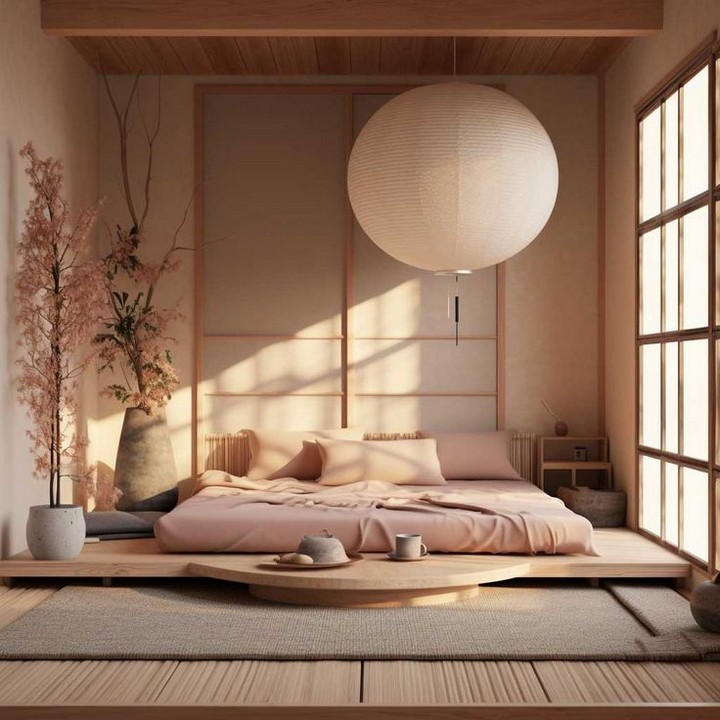
Traditional lighting with contemporary applications:
- Handcrafted washi paper pendants
- Custom-designed modern interpretations of traditional forms
- Battery-powered options eliminating cord clutter
- Dimmable lighting creating adjustable atmosphere
- Clustering arrangements for visual impact
These fixtures provide diffused, flattering light with cultural authenticity.
30. Integrated Architectural Lighting
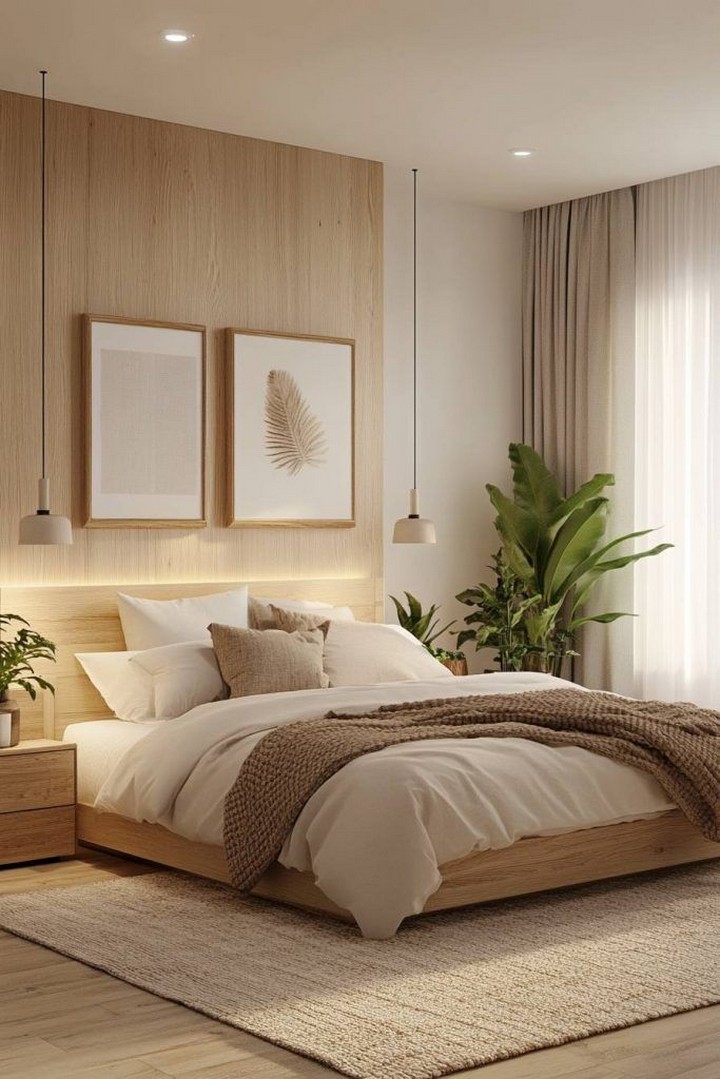
Subtle illumination supporting Japanese aesthetics:
- Recessed lighting highlighting textural wall treatments
- LED strips behind shoji screens or wood panels
- Floor-level pathway lighting for nighttime navigation
- Tokonoma accent lighting highlighting art displays
- Automated systems minimizing visible switches and controls
This approach maintains clean lines while providing practical illumination.
31. Natural Light Optimization

Working with rather than against available daylight:
- Strategic placement of beds to greet morning light
- Translucent window coverings maximizing light while maintaining privacy
- Reflective surfaces bouncing natural light deeper into rooms
- Plant placement considering natural light patterns
- Seasonal adjustments to light management systems
This philosophy honors the Japanese connection to natural rhythms.
32. Candle and Fire Alternatives
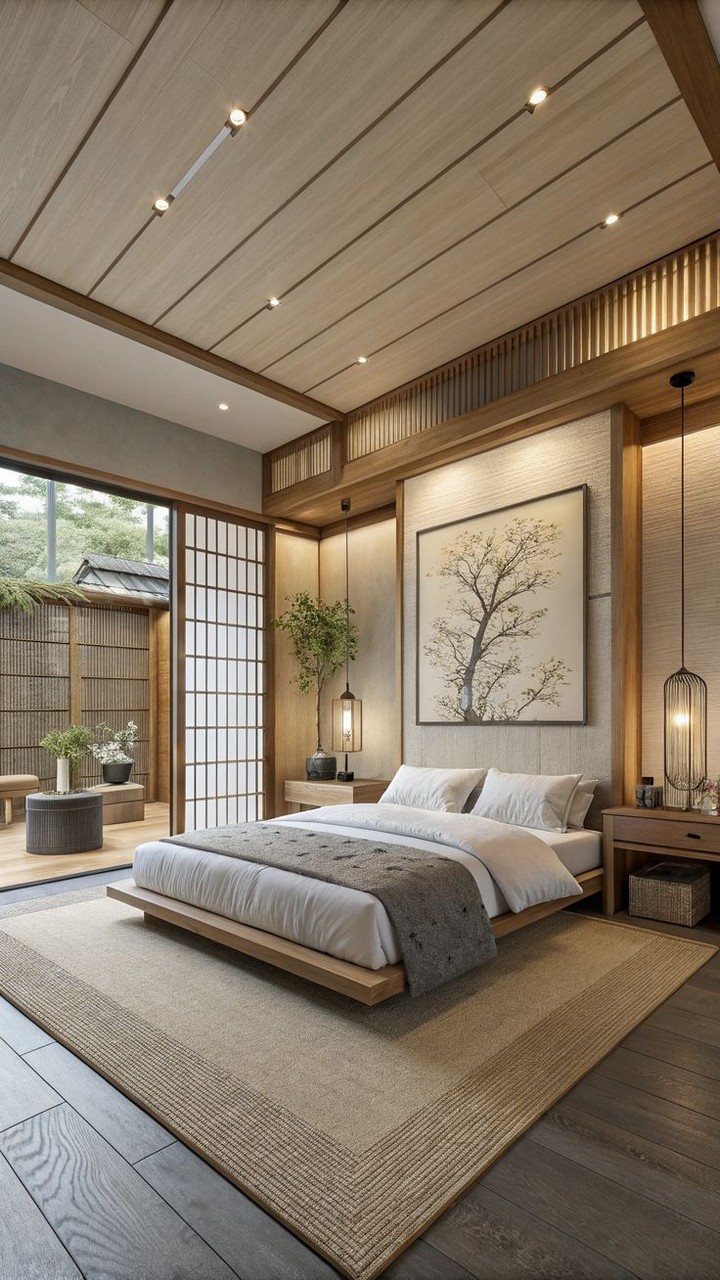
Creating the atmosphere of traditional lighting safely:
- LED candles with realistic flicker
- Traditional Japanese lantern forms with modern technology
- Himalayan salt lamps providing warm glow
- Oil diffusers with subtle integrated lighting
- Smart lighting programmed to mimic sunrise and sunset
These solutions create meditative atmosphere without fire hazards.
Contemporary Japanese Bedroom Innovations
33. Smart Technology Integration
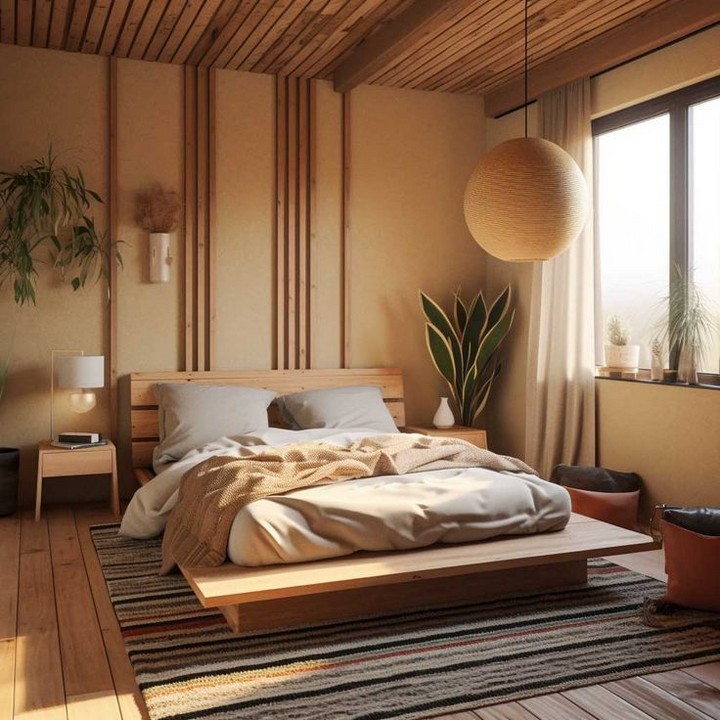
Balancing technology with Japanese aesthetics:
- Hidden charging stations maintaining visual simplicity
- Voice-controlled systems eliminating visual clutter
- Projection systems instead of mounted televisions
- Automated shoji screens for privacy and light control
- Climate control systems supporting traditional materials
This approach incorporates modern convenience while preserving traditional atmosphere.
34. Acoustic Treatments
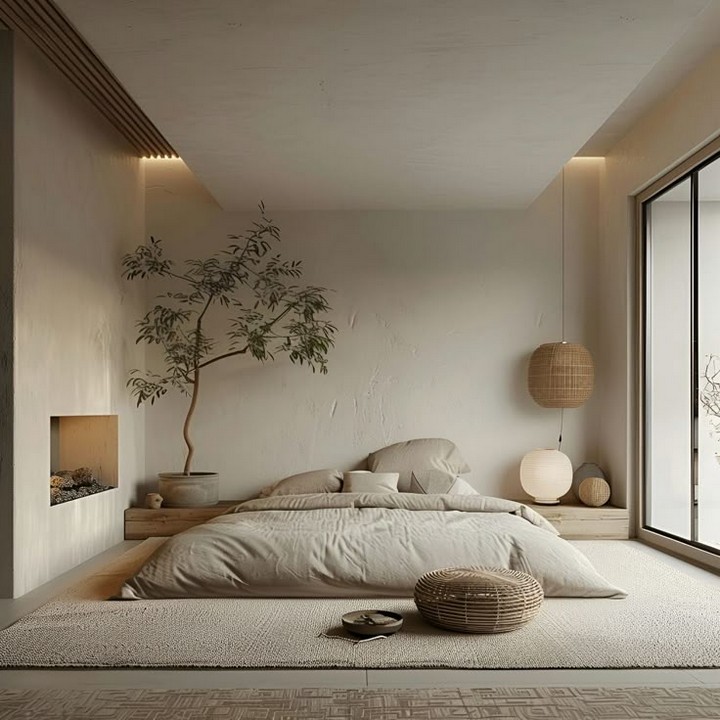
Creating the quiet sanctuary of traditional Japanese spaces:
- Custom shoji screens with acoustic inserts
- Bamboo or wood wall panels with sound-absorbing backing
- Natural fiber floor coverings reducing echo
- Ceiling treatments inspired by traditional Japanese architecture
- Window treatments providing both light control and sound absorption
These features promote the deep silence valued in Japanese design.
35. Sustainable Materials Innovation
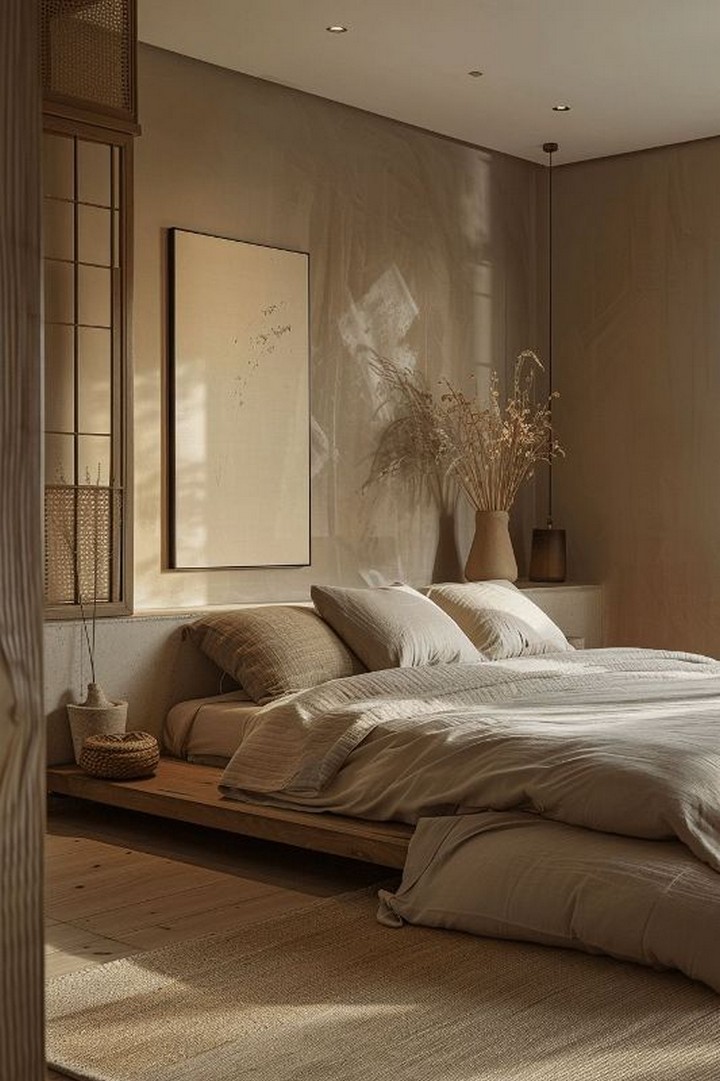
Eco-friendly updates to traditional elements:
- Renewable bamboo flooring alternatives to tatami
- Plant-based foam mattresses replacing traditional futons
- Organic cotton and hemp textiles with traditional patterns
- LED lighting in paper lantern designs reducing energy use
- Water-saving features in attached bathroom areas
These adaptations honor Japanese respect for nature through modern sustainability.
36. Biophilic Design Elements
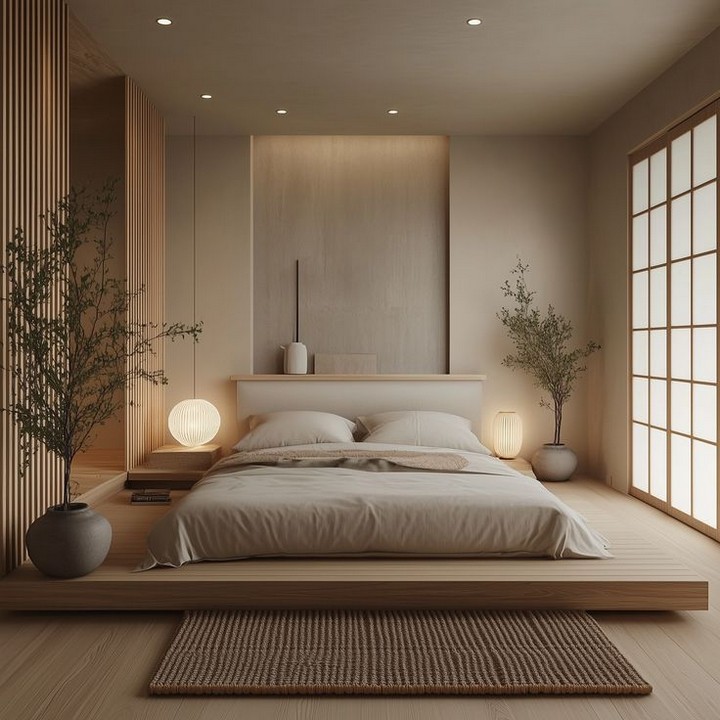
Strengthening connection to nature through design:
- Living walls featuring Japanese forest species
- Natural ventilation systems inspired by traditional architecture
- Circadian lighting supporting natural sleep rhythms
- Indoor/outdoor flow between bedroom and private gardens
- Natural soundscapes enhancing sleep environment
This approach deepens the Japanese tradition of nature connection.
37. Multi-Generational Adaptations
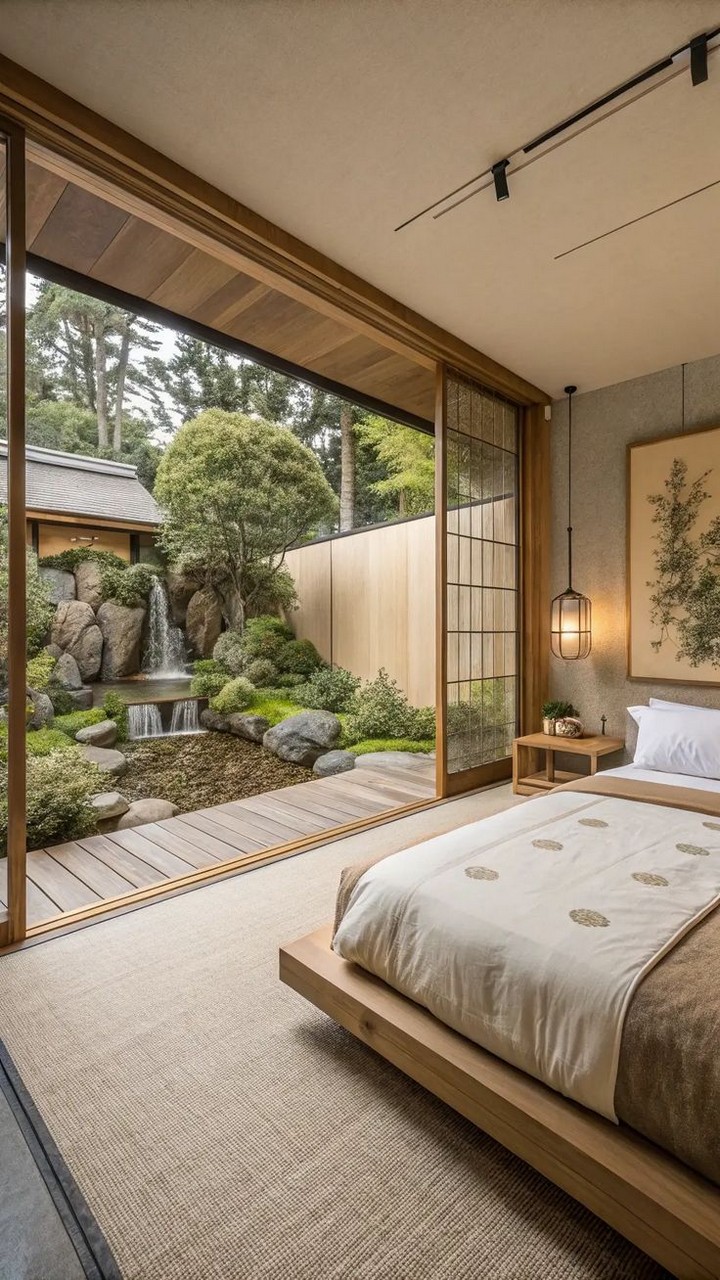
Making Japanese design accessible throughout life stages:
- Adjustable platform heights accommodating mobility changes
- Traditional elements simplified for easy maintenance
- Technology supports integrated discreetly for aging in place
- Family heirloom displays honoring Japanese tradition of ancestry
- Flexible spaces accommodating changing household needs
These thoughtful designs allow Japanese aesthetics to serve throughout the lifespan.
Creating Your Own Japanese-Inspired Bedroom
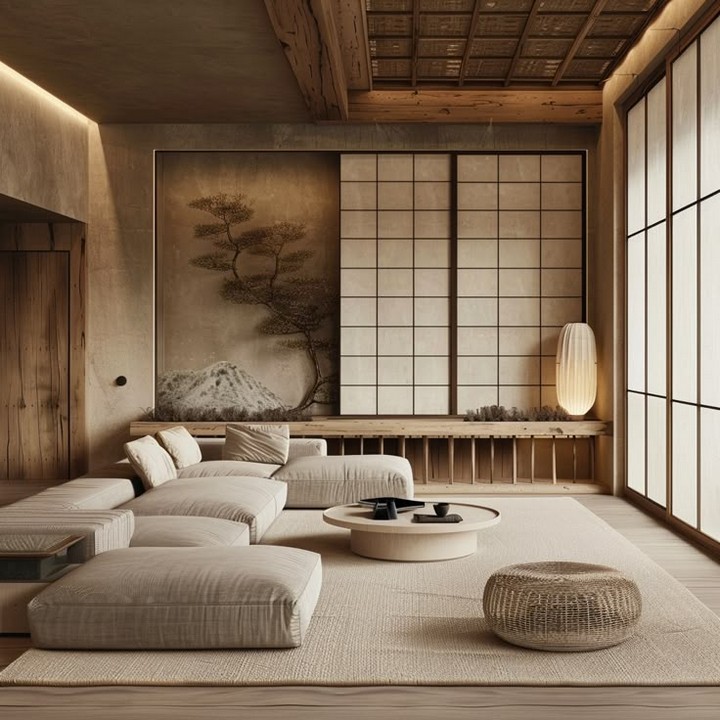
Incorporating Japanese bedroom design doesn’t require a complete renovation. Consider these approachable starting points:
- Begin with decluttering – The foundation of Japanese design is open, uncluttered space
- Choose natural materials – Replace synthetic elements with wood, cotton, paper, and stone
- Lower your bed – A simple platform bed instantly shifts the room’s proportion
- Simplify your color palette – Reduce to 2-3 neutral colors with minimal accents
- Edit your accessories – Display fewer items with more intentional placement
- Add plant life – A single, well-chosen plant adds life and connects to nature
Remember that authentic Japanese design values quality over quantity and simplicity over complexity. Even small changes can significantly shift your bedroom’s atmosphere.
Finding Your Personal Japanese Aesthetic
Japanese bedroom design offers a compelling alternative to typical Western approaches. By emphasizing minimalism, natural materials, and thoughtful space planning, these bedrooms create sanctuaries for rest and rejuvenation. Whether you embrace traditional elements like tatami and futons or prefer modern interpretations with platform beds and integrated technology, Japanese design principles provide a framework for creating serene, beautiful bedroom spaces.
The 37 designs explored here represent various interpretations of Japanese aesthetics, from strictly traditional to contemporary fusion. Each offers valuable insights for adapting these principles to your own home, regardless of size, location, or budget.
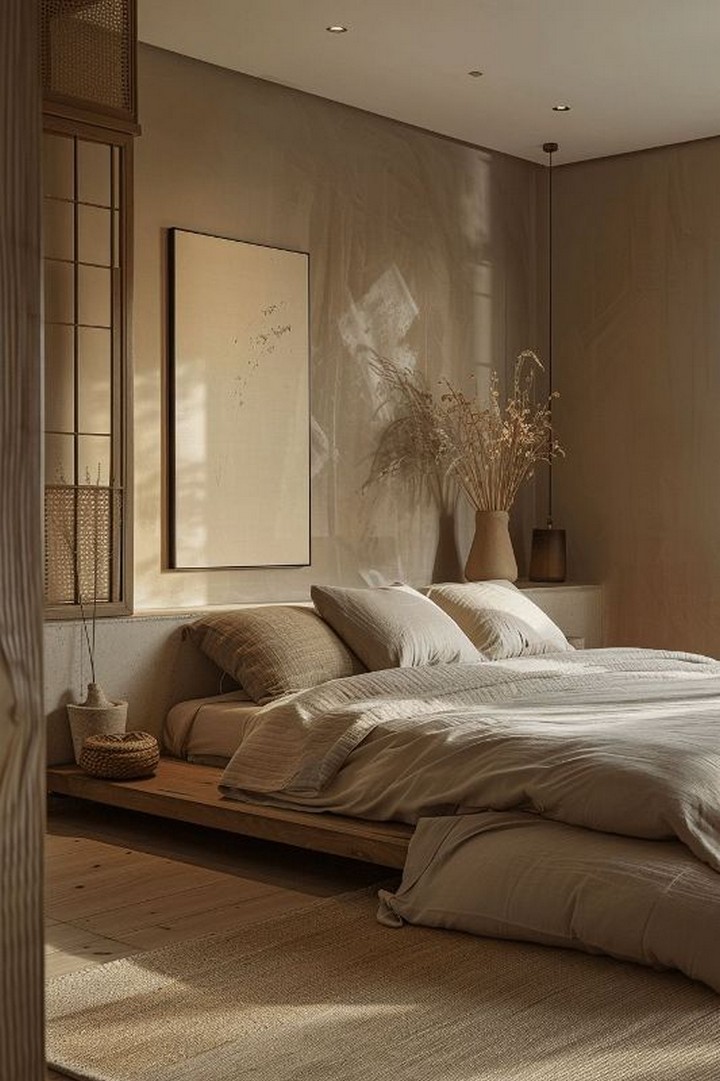
Have you incorporated Japanese design elements into your bedroom? We’d love to see your interpretation! Share of your Japanese-inspired bedroom in the comments below or tag us on social media. For more inspiration on Asian-influenced interior design, explore our related articles. And if you have questions about adapting these designs to your specific space, our design consultants are just a message away.
Happy decorating! 🏯🎋

